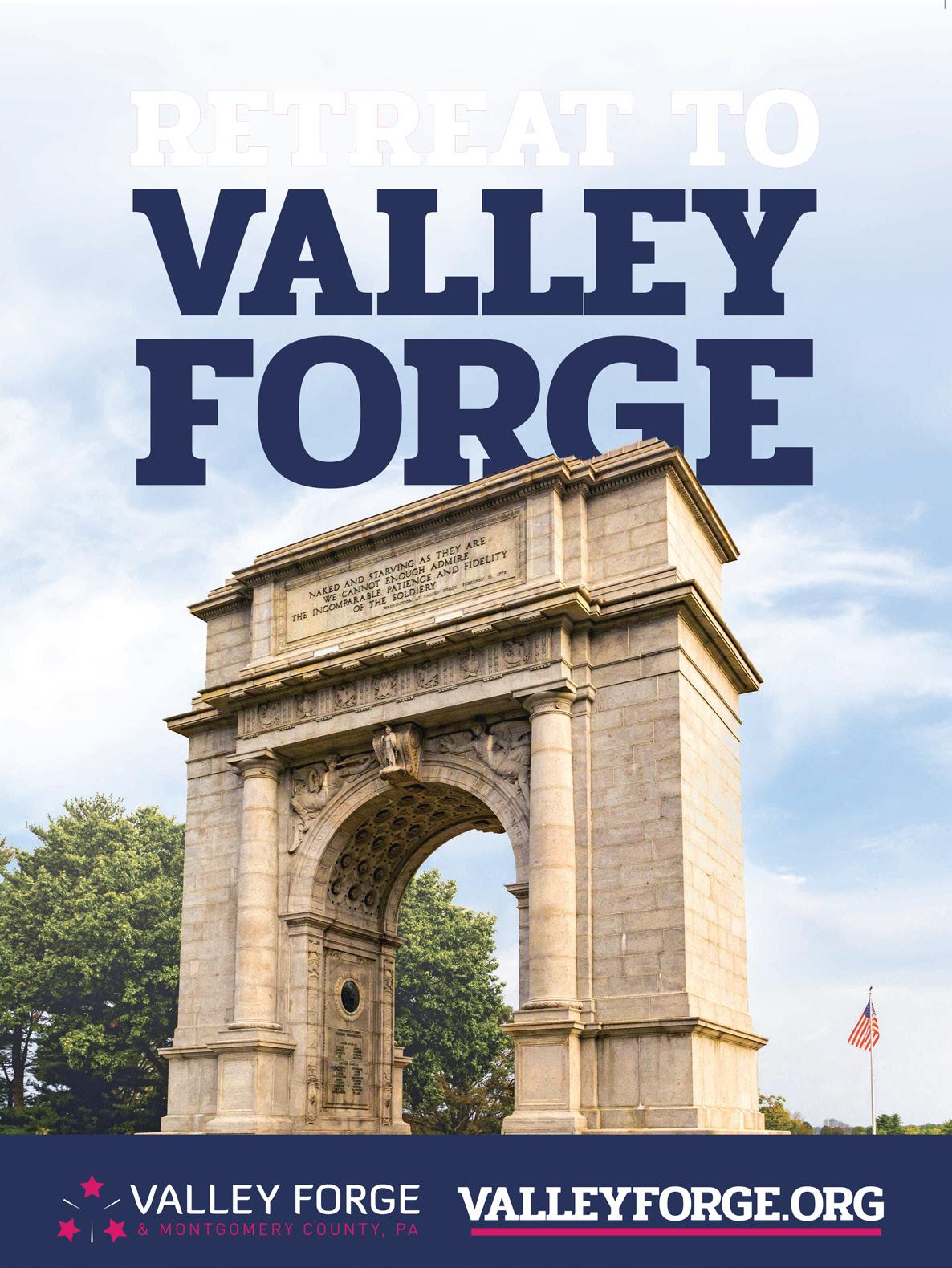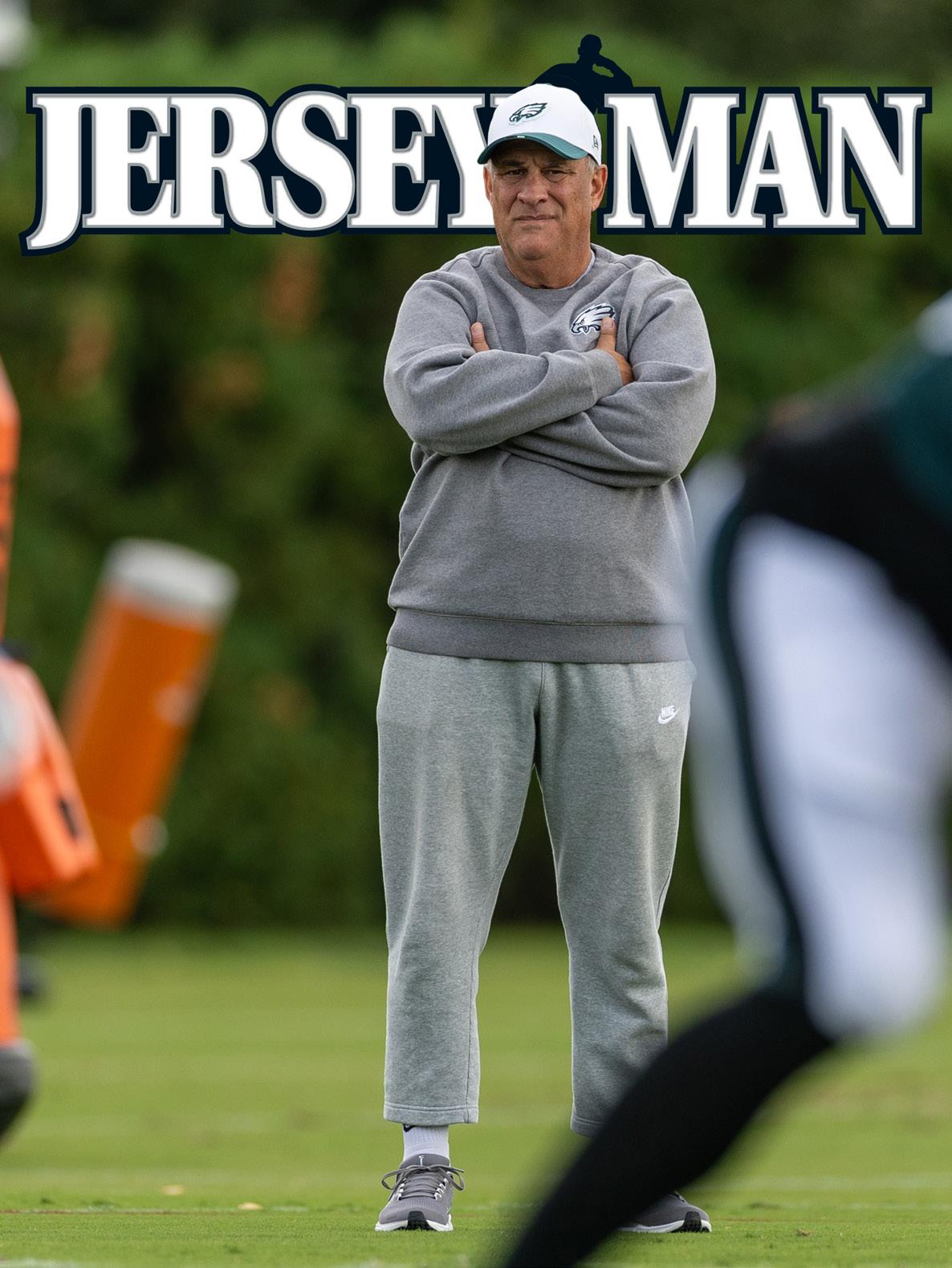
“In


“In
Eagles Defensive Coordinator Vic Fangio









BY KEN DUNEK
THERE IS A COLD SNAP in the morning air as I brush through the newly formed cobwebs on the trees near my driveway making my way to an Eagles game.
As I hit the obligatory traffic near Lincoln Financial Field, I open my window and hear the sizzle of bratwurst and cheesesteaks on the grill and spy several adult beverages in hand that help wash them down.
Music wafts through the air, and those tunes battle other songs that are also in their vicinity.
Dads are playing catch with their sons and daughters, while cornhole pods are lofted in the air searching for the magic circle.
There is pure joy at these events for the most part, although I am told the scene can get pretty ugly after the games, especially to those visitors from the opposing city wearing their colors.
Having played collegiately and professionally, the game has taught me many great lessons.
As you know, we sprinkle words of wisdom through our publication, and these are themed according to the subject matter in the magazine. And our fall issue always centers on football.
Here are a few gems from the coaches I was lucky enough to play for.
Richard Williamson (Head Coach, Memphis State Tigers)
“Play hard, but don’t do it for me. Play hard for the people that traveled hundreds of miles to come see you play today. Play hard for your Mommas and Daddies that sacrificed to get you here. Play hard for your scholarship that is giving you a free education. Play hard for your own reasons, but play hard!”
Dick Vermeil (Head Coach, Philadelphia Eagles)
“Don’t kill time, work it to death.”
“Players with talent can win you games, but talented players with character can win you championships.”
Jim Mora (Head Coach, Philadelphia Stars)
“Every day you either get better or worse, you don’t stay the same. If you do nothing that day you will get worse. So take the opportunity to improve each and every day.”
These lessons are not only good for football, but are good life lessons as well.
So, get better daily, use your motivations, and play the game hard. When the clock hits zero, you can look back and be proud of your accomplishments.

Ken Dunek PUBLISHER
ASSOCIATE PUBLISHER
Ashley Dunek
EDITOR
George Brinkerhoff
ART DIRECTOR
Steve Iannarelli
CONTRIBUTING WRITERS
George Anastasia, Jan L. Apple, Michael Bradley, George Brinkerhoff, Sam Carchidi, Alexandra Dunek, Mark Eckel, Dei Lynam, Anthony Mongeluzo, Kevin Reilly, Mike Shute, Kurt Smith, Dave Spadaro
Event Coordinator & Administrative Assistant
Alexandra Dunek
Website & Digital Coordinator
Spartan Digital Solutions
Editorial gbrinkerhoff@jerseymanmagazine.com
Advertising 856-912-4007
Printing Alcom Printing, Harleysville, Pa.
Controller
Rose M. Balcavage
Sales Associates
Ashley Dunek, Terri Dunek, JP Lutz
JerseyMan/PhillyMan Advisory Board
Peter Cordua (Chairman) Cordua Consulting, LLC
Don Eichman Alcom Printing
Bill Emerson Emerson Group
Jerry Flanagan J Dog Brands
Damien Ghee TD Bank
Bob Hoey Janney Montgomery Scott
Kristi Howell ........ Burlington Co. Chamber of Commerce
Ed Hutchinson Hutchinson
Robert Kennedy ................... Waterworks Metrology
Anthony Mongeluzo PCS
Charlie Muracco CLM Advisors
Ryan Regina Big Sky Enterprises
Scott Tanker Tanker Business Solutions
Joe Tredinnick Fulton Bank
Jim Wujcik The Joseph Fund
“Today I will do what others won’t, so tomorrow I can accomplish what others can’t.”
– Jerry Rice
www.jerseymanmagazine.com





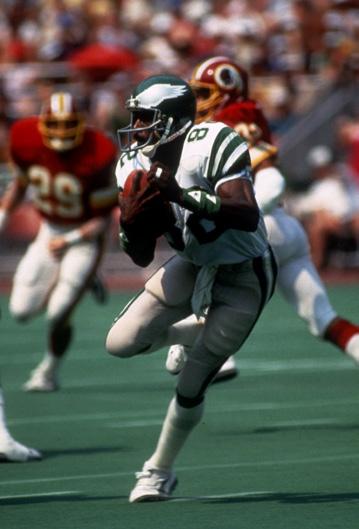


BY GEORGE BRINKERHOFF
“When you’ve got something to prove, there’s nothing greater than a challenge.”
– Terry Bradshaw
NDURANCE. It’s one of the strongest indicators of the success of an idea. As JerseyMan’s longtime Legacy Club member and former advisory board member Jeffery Jaskol [who offers investment advisory and financial planning services through Summit Financial, LLC, an SEC Registered Investment Advisor doing business as The Jaskol Group] says, his Fantasy Football league is one of the oldest … and is still going strong after 40 years!
The Vince Lombardi Memorial Football League’s original season was way back in 1985! As Jeff Jaskol tells it, the “originals” all worked at Ma Bell [the colloquial name for the AT&T telephone monopoly that controlled much of the telephone business in the 20th Century], and there are two original teams still playing, “the Fabulous Thunderbirds (Paul) and the Raging Bulls (Ken). Paul started with his brother David, whom I worked with, which was how we came into the League. Paul now has his oldest son Matt with him. At some point his younger sons wanted in, but that didn’t work out, so they are now their own team – the Wrongful Heirs (X and Y) and enjoy the competition against their brother and their father for bragging rights. The Thunderbirds own the most championships.”
“Since we started when there were no guides, our founders thought about every detail of the game, and we built our own scoring system we continue to use today. The theory was the “big play” - a long touchdown run, a pick six, punt return for a touchdown, and rarest of all, a kickoff return, occurred less frequently than other plays, so we assigned them higher point values. Our scores regularly include 99-96 shootouts decided over an extra point or two-point conversion. The amazing thing was that they figured all of this out by hand, in their heads, and hand checked all the statistics. The old guard loves our scoring and our differences from any other league we have ever seen or participated in. Our kids tell us we are nuts, but most have come around to our thinking that our games are more exciting and play down to the last play on Monday night for the eventual results.”
“Dave worked with me and by 1988 they needed another team, and he approached me and our co-

worker Al to form a new team – creatively named the DOBs - Dave’s Office Buddies. We show up at the draft – always in person except for Covid – and someone else has withdrawn – so Al and I draft two teams – the DOBs and the BODs – Buddies of Dave. The next year

Al
“Back then we scored in paper. Every Monday on my way to work I stopped at a local newsstand and bought out their supply of USA Todays, for they used the Elias Sports Bureau for scores, which was our official stats provider. My office, which now had three teams in the fray, didn’t get much work done on Mondays during the season.”
“The teams kept populating by word of mouth - a friend here, a brother there.”
“My son Andrew turned 13 and I brought him along to the draft. That was 24 years ago, and we had our first two generation team, and later my son Adam joined when he turned 13. There are now about half the teams officially in two generation status.”
“By now, internet scoring had come about. We were a Beta site for our original partner which became RT Sports, now one of the top professional fantasy outfits. We always thought how long a play was mattered, so we actually asked them to track the yardage of an interception or fumble return, just like a kickoff or punt return and they included it for us. In most leagues, that is now a staple. So, we were the founders.”
“I conclude with what you cannot replace – the camaraderie of 25 or so guys, and now many of their sons, that have gotten together every year for 40 years to pick on each other, kibitz, share stories and news. It’s an irreplaceable love that I hope never ends. See you in ten years at 50!”

IT HAS BEEN 50 YEARS since the brawling and multi-talented Philadelphia Flyers won their last Stanley Cup, but the bond between the fans and those players is still remarkably strong.
Win a championship in Philadelphia, and you are loved forever.
That’s one of the themes of “Bullies,” a new book by JerseyMan Magazine contributor Sam Carchidi and Jeff Hare that goes behind the scenes and uncovers some never-beforetold stories about the Broad Street Bullies –some of them heartbreaking, some of them oh-so uplifting.
It’s not a recap of their accomplishments –Stanley Cup titles in 1974 and 1975, a monumental win over the Soviet Red Army in 1976 –but a look back at what the players and front office went through to get to the top. On and off the ice.
Some of it is painful, some of it is surprising (the parade madness that forced a star player to go home), and some of it will leave you laughing out loud, such as the crazy stories that surround the Flyers’ unofficial hangout, Rexy’s in South Jersey.
The book is available on Amazon.com or at local bookstores.
Carchidi, Hare, and producer Susan Blanchard Ryan are also negotiating with networks to make “Bullies” a TV series, one they describe as “when Rocky meets Slapshot meets Boogie Nights.” – S.C.

(1945-2025)
Ice hockey fans and especially Philadelphia Flyers fans the world over said a heartfelt goodbye recently to one of their favorite Flyers players of all time. The Philadelphia Flyers paid tribute to one of their finest goaltenders and most beloved alumni thusly:
“Bernard Marcel Parent was an original Flyer.
He delivered the club’s two Stanley Cup Championships in 1974 and 1975, both of which culminated in a dominant and flawless performance in the clinching game of each series with a pair of shutout victories and earned him the Conn Smythe Trophy as the Most Valuable Player of the playoffs.
His career as a Flyer would also see him win two Vezina Trophies as the best goaltender in the NHL in 1974 and 1975. He is the first Flyer to be inducted into the Hockey Hall of Fame in 1984, and is one of six players on the Flyers to have his No. 1 retired to the rafters in addition to being inducted into the inaugural class of the Flyers Hall of Fame in 1988.
The legend of Bernie Parent reached far beyond the ice and his accolades. Bernie had a deep love for Philadelphia and fans of the Flyers. He was passionate about his role as an ambassador for Ed Snider Youth Hockey & Education and inspired an entire generation of hockey fans. He dedicated his time, energy and enthusiasm to not only grow the game, but also to spread joy to anyone he encountered.
Anyone who had the pleasure of being around Bernie always walked away with a smile. He will be dearly missed. We offer our condolences to his beloved wife, Gini, and the entire Parent family.”


AS PART OF A CHANGE to the naming rights of the entertainment venue in the Philadelphia Sports Complex in South Philly known as “XFINITY Live!”, its name will soon be recast sometime in the Fall of 2025 as Stateside Live! The new name comes via the participation of Stateside Brands, the wildly successful Phillybased distillery which launched in Kensington in 2015, introduced Stateside Vodka Sodas in 2021. They then introduced their popular Surfside line of award-winning, vodka based iced teas and lemonades in 2022, which can now be found in all 50 states and some international territories and is currently the fastest growing spirits brand worldwide! The venue name change coincides with a previ-
ously announced $20 million dollar expansion which will include a brand-new concert stage, five new bars, a two-story VIP building featuring an upscale rooftop oasis, an upgraded turf area, and public art installations integrated throughout the plaza.
“If you really look at the epicenter of our growth, it is rooted in Philadelphia, but particularly Philly sports,” said Matt Quigley, President and Co-Founder of Stateside Brands. “We built our following one sporting event at a time, over a decade of tailgates and supporting our teams. This naming rights partnership is a full-circle crowning moment, and we look forward to many more years of building upon the excitement and privilege it is to be a fan in Philadelphia.”


Fall is a great time for hiking in New Jersey, but watch out for these two guys. The Timber Rattlesnake and the Nothern Copperhead are the only two venomous snakes endemic to the state. Timber Rattlesnakes can reach up to six feet in length, and the smaller Northern Copperheads are generally 2-3 feet long. All snakes in NJ are protected under the Endangered and Non-Game Species Conservation Act. And while the chance of being bitten is slim, they will defend themselves when threatened, so step lively!


Legacy Club at Carlucci’s Waterfront – Mount Laurel, NJ

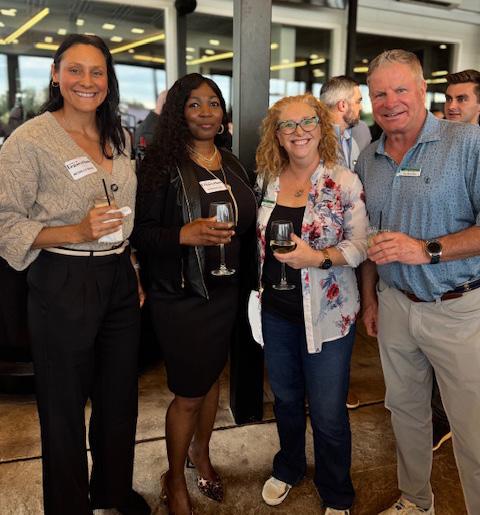




BCRCC Cornhole Tournament – Trenton, NJ
JerseyMan got 2nd place!


Chairman’s Club Dinner with Dick Vermeil – Raza’s at Hamilton

Cornhole Tournament at Boomerang – Pennsauken, NJ
Congrats to winners Greg Wilkins & Harry Bickel






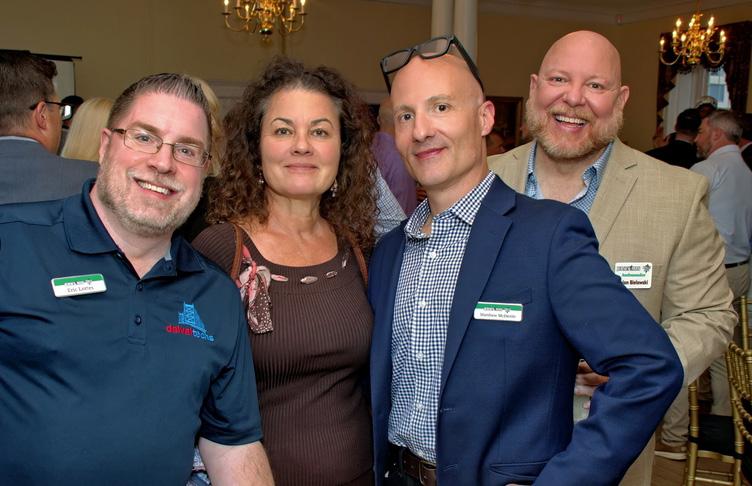
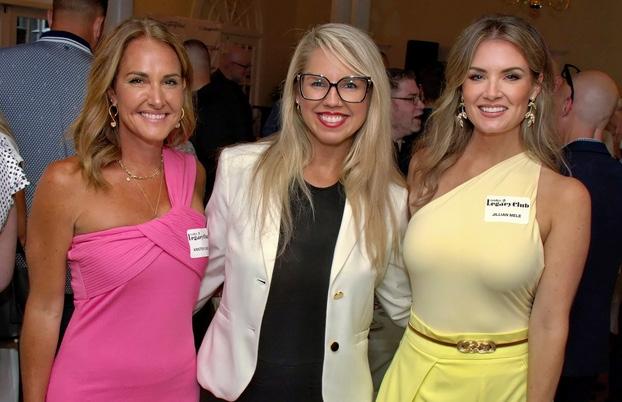


Ladies of Legacy Wine Tasting with Nina from Traino’s Wine & Spirits





BY GEORGE ANASTASIA
IT MIGHT HAVE BEEN one of the first mob hits in American history... And the repercussions are still being felt today.
It happened over 100 years ago.
On October 16, 1890, the sheriff of New Orleans, David Hennessy, was gunned down as he walked home from work. His last words, according to some reports, were “the dagoes got me.”
Those words set the tone for what followed. There is a memorial plaque and a 26-foot obelisk of a police baton that mark Hennessy’s tomb in Metairie Cemetery in New Orleans. History has been good to him, although his full story would include allegations of corruption and his arrest for murdering a law enforcement rival. That murder, in the final analysis, was ruled self-defense so Hennessy walked away from the criminal complaint.
“The dagoes” weren’t as lucky.
At the time he was killed, Hennessy was investigating Mafia activity along the docks and in other business ventures in his city. There was a large Italian immigrant population. Most of the new arrivals had come from Sicily. New Orleans offered the same kind of climate as home. Fishing and farming were also two sources of income that the Sicilians were familiar with.
While, historically, Chicago and New York have always been described as the epicenters of the nascent Mafia in America, New Orleans was in many ways as important. It was, after all, the breeding ground for Carlos Marcello, perhaps one of the most powerful and historically significant Mafia bosses in American history. There are many who believe John F. Kennedy’s murder was orchestrated by Marcello.
But that’s a story for another day. The point is, New Orleans has always been one of the power centers of the American Mafia. And the story begins with the assassination of David
Hennessy, a murder that occurred nearly 20 years before Marcello, as a child, arrived in America.
The murder of Hennessy was front-page news not only in New Orleans but across America. His dying words were used to fan the flames of anti-immigrant bigotry. More than two dozen Sicilian immigrants were rounded up by authorities in the aftermath of the murder. Nineteen were indicted. Some were suspected Mafia members. Others were simply part of the immigrant group that had been targeted.
ICE attacks on immigrants today are in many ways an echo of what was happening back then.
Due process?
Law and order advocates rallied the populace. The good citizens stormed the jail and pulled 11 of the suspects out into the streets. Several were shot. All were hung. At the time, it was the largest mass lynching in American history.
Their crime? They were Sicilian immigrants.
AMERICANS AGREED with the sentiments expressed in a New York Times editorial that was written in the wake of the New Orleans murders. The editorial referred to “these sneaking and cowardly Sicilians, the descendants of bandits and assassins, who have transported to this country the lawless passions, the cut-throat
But the defendants were not released. Instead, they were returned to the New Orleans jail while the media and political leaders expressed their outrage over this “miscarriage” of justice.
There was a trial in March of 1891, a few months after the murder. About a dozen of the suspects were brought into court. The proceedings did not end the way most authorities had hoped. No one was convicted. Many of the defendants were declared not guilty by the jury. For others, the jury hung. It could not reach a decision.
But the defendants were not released. Instead, they were returned to the New Orleans jail while the media and political leaders expressed their outrage over this “miscarriage” of justice.
Something had to be done.
practices, and the oath-bound societies of their native country.” It went on to describe Sicilian immigrants as “a pest without mitigations” and opined that “lynch law was the only course open to the people of New Orleans.”
This was the New York Times! Sadly, it accurately reflected America in the 1890s. Sadly, the story keeps repeating itself. It’s the immigrant as “other,” the immigrant as scourge, the immigrant as not worthy to be an American.
But there was more to the New Orleans story. The lynchings created an international hue and cry. At one point, the Italian government was threatening to break off relations with the
States.
Local, state and federal authorities scrambled to do something. New Orleans reluctantly agreed to make payments to the families of those who had been killed. But it wasn’t enough.
President Benjamin Harrison came up with an idea.
He would declare a day to honor Italians and Italian Americans. But what to call it? This was in 1892. Historians saw that it was the 400th anniversary of Christopher Columbus’ “discovery” of America.
And so, Columbus Day was born.
School children learned the nursery rhyme – “Columbus sailed the ocean blue in fourteen hundred ninety-two.”
Italian – and Jewish and Irish – immigrants flocked to America at the turn of the last century. But America as a “melting pot” was in many ways a myth, one offered to create a sanitized image of what life was really like for new arrivals. By the late 1930s, Italians and other ethnics who had arrived at the turn of the century began to assimilate. Politics (Fiorella LaGuardia), entertainment (Frank Sinatra) and sports (Joe DiMaggio) provided cultural touchstones, demonstrations that Italians had arrived.
But had they really?
This from a Life magazine profile of DiMaggio (whose picture was on the cover) in 1939:
“Although he learned Italian first, Joe, now 24, speaks English without an accent, and is otherwise well adapted to most U.S. mores. Instead of olive oil or smelly bear grease, he keeps his hair slick with water. He never reeks of garlic and prefers chicken chow mein to spaghetti.”
THE ARTICLE WAS considered a positive portrayal of an emerging baseball star, the son of an immigrant who had made it in America, who had taken America’s pastime by storm…and who didn’t reek of garlic.
Columbus Day became an official national holiday in the 1940s and remained a day of pride for Italian Americans for decades. It was celebrated on October 12, ironically the same month and just four days earlier than the day David Hennessy was shot in New Orleans...
Today it’s a holiday with a mixed message. There are those who prefer Indigenous People’s Day, a nod to the original Americans who were unceremoniously displaced by all the immigrants – including the white, Anglo-Saxon protestants who came here before the Italians, Jews and the Irish, and who, in many ways,
benefitted from a different form of organized crime.
Robber barons helped build the United States of America and there are prestigious universities today – Vanderbilt and Stanford being two examples – that honor their names and their accomplishments.
There are no universities named after Arnold Rothstein or Al Capone or Meyer Lansky or Lucky Luciano. They were part of the next wave of immigrants who came to the United States looking for a better way of life.
Today, there are other ethnic groups looking
for the same opportunities and, sadly, facing the same kinds of bigotry.
We can argue and/or discuss the merits of naming a day after Christopher Columbus. There are certainly reasons to challenge the original historic depictions of who he was and what he had accomplished.
But it is just as important for those who decry bigotry and prejudice and genocide while railing against Columbus to acknowledge the origin of the holiday – the brutal and unlawful hanging of 11 Sicilian immigrants whose only crime was that they were Sicilian. n



NICK NURSE IS ENTERING his third season as head coach of the Philadelphia 76ers and eighth season overall as an NBA head coach. He experienced the ultimate high as a rookie head coach, winning the NBA championship with the Toronto Raptors. His most recent season was his most challenging. Last year, the Sixers won just 24 games, despite having a roster that included the 2023 MVP in Joel Embiid, a 2024 All-Star in Tyrese Maxey, and a ninetime All-Star in newcomer Paul George. Embiid had surgery on his left knee in April after appearing in 19 games last season, and George underwent arthroscopic surgery on his left knee in July. The sentiments surrounding the Sixers heading into the 2025-26 season are skeptical. The fanbase will look to Nurse for answers on his team’s health and performance. But before he endures the rigors of another NBA season, even he cannot honestly know what to expect. Nurse refueled this summer, spending time in his hometown of Carroll, Iowa. Not surprisingly, the 58-year-old was not resting on his laurels.
Carroll has a population of 10,125. The land is vast, but the people are close. So, when Nurse learned Carroll National Golf Club, the only private course in the town, was in trouble and going to be sold to real estate developers, he stepped in and bought it in February 2024. He wanted to save it for the members. In turn, the members said, “We will support you in every way we can.”
ITRAVELLED TO CARROLL for the 2nd annual Golf and Music Festival in midAugust to support the Nick Nurse Foundation. The event included two golf days and excellent music performances each evening. They assembled a massive stage on part of the 10th hole that allowed people to sit on the grass and watch the likes of Mt. Joy, Jefferson Starship, and the Jacksons. But the warm-up band, Purple Wonder, had a special place in

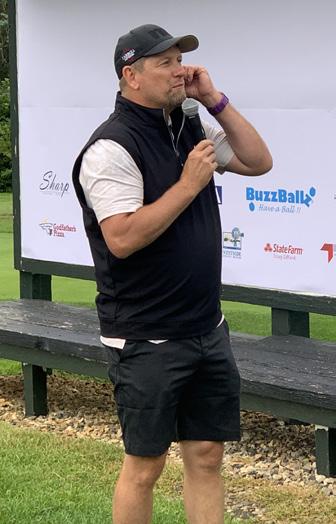
my heart because they were all individually accomplished Philadelphia musicians.
THE STORY OF PURPLE WONDER and its connection to Nick Nurse is incredible. Scott Granoff, a long-time Sixers season ticket holder, got involved with managing Purple Wonder. Upon Nurse’s arrival in Philadelphia, Granoff learned of Nurse’s love of music and ability to play the keyboard. He convinced Nurse that a jam session with Purple Wonder would be worthwhile. That took place a year and a half ago at Nurse’s house. A connection was born.
This summer, Nurse invited Purple Wonder to be the warm-up band at his event, and yes, the coach was on the keyboard. They are a high-energy tribute band to Prince and Stevie Wonder. The night before the event, Purple Wonder performed for an intimate crowd of fifty people in the clubhouse. Nurse was in his
musical element. Between sets, Nurse took the time to thank and acknowledge old and new friends for joining him in supporting the current generation of kids in Carroll, Iowa.
This year, the foundation awarded a high school girl a scholarship, the first of many such gifts in the future.
The number of people who flew in worldwide to participate in this event, including Julius Erving, was heartwarming. It spoke volumes about Nick Nurse as a person and friend. Nurse was the first person at the course to greet the golfers in the morning, sharing coffee and conversation.
Nurse shared with many was the presence of a basket and a backboard anchored to a deck railing off the clubhouse. He explained that his high school called years ago, saying they had baskets from when he was a player in storage and were getting rid of them. Nurse was asked if he wanted one. Nurse said yes, and for the past couple of years, the 600-pound backboard with a hoop has sat in his Iowa garage until August. Nurse seized an opportunity to raise more money. Pay $20 to attempt three free throws. Prizes were awarded based on the number of makes. Unfortunately for me, the basket was ten feet two inches high, given the deck’s location. Those two inches were a game-changer in the wrong direction. Many people attempted free throws, with very few makes.
Nick Nurse’s second annual Festival in Carroll was championship-caliber, from the old-school hoop to the golf to the music and the people. n



Kevin Reilly is an author, motivational speaker, and former Philadelphia Eagle. To contact Kevin Reilly, visit https://www.kevinreilly52.com
THE 2025 NFL SEASON is upon us, and compared to my playing time in the 1970s, I can hardly believe how far we’ve come.
When I was drafted, we put every fiber of our being into training camp. A lot of people don’t know that, back then, training camp was nearly twice as long. And even still, we would only have a small chance of actually playing in a regular season game. The real kicker: the salaries we competed for. They were a mere fraction of what players are getting today. But for the love of the game, I clawed my way through.
In 1973, I was drafted by the Miami Dolphins in the seventh round (160th overall) as a linebacker and special teams player.
All 22 free agents & draft picks were invited to Miami for a weekend of workouts and

conditioning. We sat silently in the Dolphins’ conference room with anxious but hopeful anticipation.
Then, the man, the coach, the legend, Don Shula, walked into the room. After some brief remarks, he distributed that weekend’s workout schedule. As we reviewed the schedule, I could see that some of the hope the others carried was starting to leave them.
Before ending the meeting, Coach Shula walked up to the podium and gave the following exhortation: “There are 22 of you in this room vying for a position on my team. We will only have three openings on the roster. I am a big believer that you leave the dance with the girl that you came with, so… the odds are very small that you will make this team. With that being said, if you want to leave here tonight, please do! Don’t waste your time – or my time!”
Two guys got up and left that night.
At camp, practices began at 7 AM. Under Florida’s 90+ degree heat, we had a grueling two and a half hours in the morning, and two and a half more in the afternoon. Best of all, no water breaks were allowed on the field. In the first week alone, twelve more guys left camp!
AFTER TEN MORE WEEKS of pure torture, I emerged victorious. I was on all of the special team’s rosters for the first game of the season. Quarterback Don Strock and wide receiver Bo Rather took the other two slots. That made us the chosen three from the camp.
On the last Friday before the opening regular season game, Coach Shula summoned me to his office. As I approached, my anxiety kicked in, just as it had on the first day of camp. What did I do wrong – violate a team rule, bad news from home – who knows?
Well, it turned out that Joe Paterno, head coach of Penn State, made a call that morning. Paterno insisted that his All-American,
Jets 2nd round pick, Bruce Bannon, should take a spot on the Dolphins’ roster that year. In Paterno’s vision, he saw Bannon as the perfect backup for Bob Matheson, the only edge rusher in the league. Both Bannon and
Best of all, no water breaks were allowed on the field. In the first week alone, twelve more guys left camp!
Matheson stood just shy of 6’4” and 240lbs, and together would be a force to be reckoned with.
But all I could hear was this: I was being cut. My head dropped, defeated. At the sight of this, Shula jumped out of his chair. He said, “Hey, look at me. Pick your chin up. You didn’t get cut from the Phoenixville Minor League team; you got released from the Super Bowl Champion Miami Dolphins. Trust me, you’ll be playing within two weeks.”
You know what? He was right. I hooked up with none other than the Philadelphia Eagles, where I played two seasons before getting traded to the New England Patriots. (Footnote: I played with the Patriots before they started cheating!)
Oh, but I’m sure you want to know what our salaries looked like: Roman Gabriel, $75 thousand; Bill Bergey, $55 thousand; and Kevin Reilly, $17.5 thousand. Things sure have changed over the last 50 years, and I’m proud! I shout from the bottom of my heart, “GO BIRDS!” because I still see them out there, giving their all for the love of the game. n

BY ALEXANDRA DUNEK
PROTEIN BARS and pre-workout powders are a thing of the past. Companies are now launching innovative, “gym candy” that are more fun to eat if you are getting tired of old school supplements. If you are a candy lover and looking to try something different, these options are worth checking out.
This concept seems to be fairly new on the market, so there aren’t many options available, but the brand Gym Candy offers an 8-pack variety of gummy candy that has 18 grams of protein in one serving. I was able to try two different flavors: a rainbow flavor called Gainbow and a fruity flavor called Gym Crush. They are shaped like bears and have an erythritol coating on top. If you have a sweet tooth and want to ditch your average protein bar, these are a good alternative for some quick protein.
Creatine has many benefits for both men and women, such as increased strength and quicker recovery. No need for a shaker bottle with convenient creatine gummies. It’s important to look for companies that are third party tested to ensure purity and potency like the brand Legion. They offer five different flavors with five grams of creatine per four gummies.
www.legionathletics.com


Gains in Bulk is a favorite supplement company of mine, and they have “workout candy” with 30mg of natural caffeine that you can eat prior to your workout to boost your energy. The serving size is three chewable tablets, and they are similar to a hard candy that dissolves in your mouth. The texture and flavor resemble the candy Necco Wafers.
www.gainsinbulk.com n


BY MIKE SHUTE

after something bad happens to you? It’s a question Jay Wright, the two-time national championship coach of the Villanova University men’s basketball team, posed to his players almost daily during his tenure with the Wildcats. The idea was to prepare them to stay focused and resilient under the most intense moments of competition.
And the answer that local actress, writer, acting coach and filmmaker Lisa Regina has crafted to that very question over the past 20 years is nothing short of amazing, creating and building positivity out of what was a horrible experience. Rather than wallow in selfpity, she’s found ways to climb out of darkness and bring others up in the process.
After being violently assaulted and thrown out of a moving vehicle on the streets of New

York City by her then-fiancée just two months ahead of their planned wedding, Regina took that pain and the immense feelings of trauma and eventually found a way to build that into positives, not just for herself but for many others, specifically United States military veterans. Through her physical and mental healing, it’s been a steady building process and a jigsaw puzzle that has seen her take many steps along the way, landing her near the precipice of what she believes is a compilation of years of learning, creating and giving as she works toward the development of a television series entitled Heroic Episodes. Her efforts have caught the eye of Joe Mantegna, the TV and movie actor/ director, who is on board with Regina’s project as an executive producer.
A survivor, she says “the trajectory of my life changed” from the event 20 years ago.

A little more than a year after her assault, she founded the non-profit 501(3) (c) foundation, A Write to Heal. Regina went on to be a keynote speaker for the YWCA after originally sharing her story with the New Jersey Coalition for Battered Women. Meanwhile, her experience in New York City, not just the assault, but her time as a non-traditional student studying in the film industry at NYU and eventually working professionally in the industry, gave her the knowledge and ap-
“What helpedreally me heal was writing. I was able to help a lot of people.”
preciation for what writing can do and how it can help individuals deal with handling their feelings.
“What really helped me heal was writing,” Regina recalls. “Just releasing that pain because you have so much bottled up, and then I shared a lot of that writing with women who were in my domestic violence groups. It was part of who I was and as I traveled the country talking about my experiences, I was able to help a lot of people.”
A Triton High School graduate whose family moved to Gloucester Township in South Jersey from South Philadelphia, she was also able to travel and speak internationally and learn to understand violence against women in other parts of the globe.
“I really learned that I was lucky to be alive to share my story and help others.”

Another turning point for Regina occurred in 2012, while she was teaching and coaching actors through a workshop, she was introduced to a female military veteran who was an amputee and legally blind, suffering these injuries while serving in Bosnia.
“Her name was (Ret. U.S. Army Captain) Leslie Nicole Smith (plus her service dog Isaac), and she eventually became the very first ambassador when actor Gary Sinise founded his Gary Sinise Foundation. She called me and wanted to take my workshop. She was

“It will be more than a TV series. It will provide job opportunities for both veterans and at-risk youth.”
amazing and came into my workshop, which had about 30 actors. A lot of the people in the workshop thought, ‘What is she going to be able to do?’ But she had the will and the ability to overcome her obstacles. The group was very inspired by her, as I was too. Yet she told me how she was inspired by me and how I was trying to take the educational path to help others who were suffering in different ways. There was a mutual appreciation there and we really bonded. But for me, as someone who was not in the military, I was able to develop a deeper understanding of the wide variety of unique challenges our veterans face.”
From that mutual respect and appreciation of one another, Smith became an ambassador for Regina’s non-profit. She was also a huge

inspiration in Regina’s creation of Heroic Episodes, as she tries to build a television series centered on telling the true stories of veterans and military members and their unique experiences and their abilities to overcome.
“The goal is to shine a light on what these military members, first responders and firefighters have been through and to share their
stories,” Regina explained. “Since meeting Leslie, I’ve spent about 12 1/2 years meeting other people like her with military backgrounds, veterans, fire, police, and interviewing them and getting their stories and adapting them into this television series that I’m writing.”
The plan, with the help and credibility of Mantegna, is to film the pilot episode of the

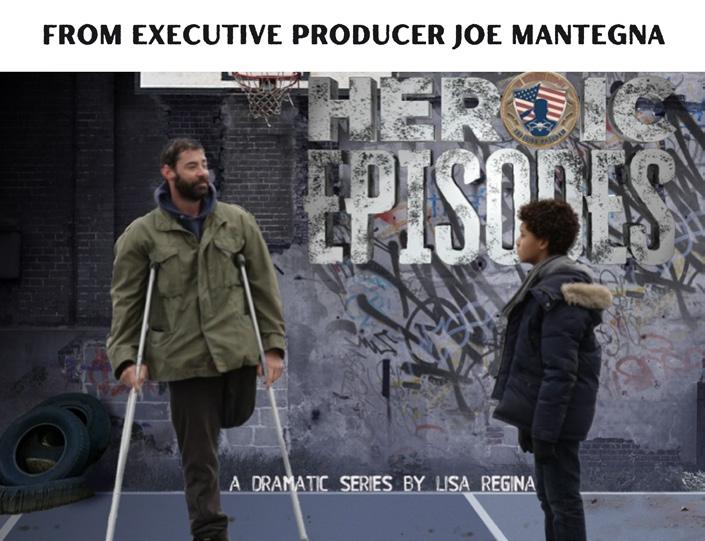
series next year in the Philadelphia region, both in the city and the South Jersey suburbs. She says the concept of the show has the grit and reality of HBO’s The Wire, and mixes that with the heart and soul of the 1984 hit film The Karate Kid. It’s about the bonding of an injured veteran and an inner-city teen, their relationship and how they and their peers affect and help one another.
“It will be more than a TV series. It will provide job opportunities for both veterans and at-risk youth. It will also provide healing and empowerment for some of those who are in some of the real underserved populations in our community. It’s a reflection of decades of my advocacy work and experiences with that.”
But along the way, Regina has also found another way to inspire and help former military members with her non-profit’s Veterans Drone Training Program (VDTP). The program helps veterans to become Part 107 Commercial Drone Pilots by partnering with the Atlantic County Economic Alliance and Atlantic Cape Community College and they applied for a congressionally funded grant in March of 2023. The grant allowed
for a dozen veterans to take these courses, in person, over about a four-month period. And they each were awarded a drone from her nonprofit as part of the course.
“I’m a drone pilot with a Part 107 Drone Pilot License. I use them for filmmaking. Many veterans have unique experience and understanding of flying aircrafts. This program is a chance for veterans to heal from the traumas of war and really assimilate back into civilian life through job training and opportunities in the aviation and film industry. We can provide veterans with these skills and prepare them for the Federal Aviation Administration exam. And we developed a program to provide them with the training and the hard skills that they can use in the film industry, or search and rescue, real estate, even agriculture. There are so many opportunities in the drone industry, and it’s a great fit.”
That initial grant impacted veterans of different varieties, from older veterans from Vietnam, to veterans of more recent conflicts. The 2023 grant money has expired, so she’s continuing to apply for new grants, raise money and helping veterans continue to have access to online courses to acquire their drone licensing. And she’s able to assist veterans not just locally but anywhere in the country because of the online courses.
Clearly, Regina has not let the unfortunate situation that changed her life 20 years ago bring her down or hold her back. She has taken a mindset that has allowed her to figure out how to bounce back from a horrible situation and she’s bringing others back from the depths of mental and physical trauma, raising others up in the process.
“I’m really hoping to partner with and sit down and speak to philanthropists and likeminded people in the area who have similar views and share their thoughts about how they could give back and develop other ways we could impact veterans, first responders and those underserved populations.” n

You can learn more about Regina’s non-profit, find out how you can volunteer or give tax-deductible donations to the cause and aid in helping her mission of assisting veterans and first responders discover ways to improve their quality of life by visiting www.awritetoheal.com. To learn more about Heroic Episodes, visit www.heroicepisodes.org.



BY MARK ECKEL
“Listen, during my era I made what everyone considered was a lot of money, so I’m happy for these guys and the money they’re making,” Quick said. “When you put your body on the line and do what they ask you to do, you deserve what you get.”
Then he quickly adds.
“If I was making the money these kids make now, I wouldn’t even be talking to you,” he said, laughing. “I would be somewhere on an island just chilling and have someone fanning me.”
Quick, one of the greatest receivers in Philadelphia Eagles history, does talk to you every Sunday, or Monday night, or Thursday night, or whenever the Eagles play. And he has been for 28 years now.
When Stan Walters moved to England after the 1997 season, Quick was hired as the Eagles radio color analyst, and he’s sat in the booth next to Hall of Fame play-by-play man Merrill Reese ever since.
“It’s the way things have worked in my life,” Quick said. “It’s how God has worked in my life. I’ve been given opportunities to do things that I didn’t expect, and they worked out. It’s never been my plan. It wasn’t my plan to do radio for 28 years. It wasn’t my plan to have a nine-year NFL career. I’ve been afforded these opportunities, and when they came, I jumped in and tried to make the most of them. I didn’t want to be a guy who gets an opportunity and screws it up.”

YOU PROBABLY KNOW THE STORY of how
Quick became an Eagle in the 1982 NFL draft. Then head coach Dick Vermeil wanted Perry Tuttle, a receiver out of Clemson, in the first round. Vermeil liked Tuttle so much that he told too many people, including Buffalo head coach Chuck Knox. The Bills traded up ahead of the Eagles and took Tuttle, leaving Quick, out of ACC foe North Carolina State, for the Eagles.
Quick played nine years, all for the Eagles. While his numbers speak for themselves, there’s more to his story. After sitting out most of his rookie season, Quick became one of the league’s best receivers from 1983-86. And the Eagles went 5-11, 6-9-1, 7-9, and 5-10-1. So, while Quick was great, the Eagles were bad. Then, when the Eagles got good, Quick’s knees gave out from whatever that surface was that the team played on at Veterans Stadium.
There’s also the fact that Quick’s quarterbacks were an aging Ron Jaworski when he started and an inexperienced Randall Cunningham when he finished. Still, in those four

“
I LIKE BEING AROUND THE GAME. I LIKE GETTING CLOSE TO THE PLAYERS AND THE COACHES. I REALLY LIKE NICK SIRIANNI. I LIKE BEING INVOLVED WITH THE BEST ORGANIZATION IN SPORTS.”
years from 1983-86 he caught 262 passes for 4,647 yards and 42 touchdowns. Even in the strike-shortened 1987 season, he caught 46 passes for 790 yards and 11 touchdowns in just 12 games.
And that was before the NFL turned into the pass-first game it is today.
“When I played the game in the ‘80s, first down you ran the ball, second down you ran the ball, third down you passed the ball,” Quick said. “Today, you start the game with three wide receivers on the field, and 65 percent of the time, you have three wide receivers on the




field. It’s a passing game. It’s fast break football now as opposed to what it was then.
“I wish it was more open when I played. Some teams did it, Houston had what Buddy Ryan called ‘The Chuck and Duck offense.’ San Francisco, with Bill Walsh, had the West Coast Offense and threw the ball more. But for the most part, you ran first.”
QUICK’S LAST SEASON was 1990, the Eagles third straight playoff year. But his knees allowed him to play just four games that season and a total of just 18 in the three playoff years.
And when he walked, or limped, away, he was gone, just as he was when he took a Jaworski pass and went 99 yards for a touchdown in an overtime win over Atlanta in 1985.
“I completely got away from football,” he said. “I needed a break. I knew the transition would be difficult. I needed a real good period to purge and take a break from football. I didn’t even watch the game. I remember I was down in Hilton Head, South Carolina playing golf. We made the turn and stopped in the clubhouse to get refreshments, probably a beer. The Eagles were playing Green Bay. And Randall had just gone down with that knee injury after that hit from Bryce Paup. I wasn’t even paying attention and just happened to stop in the clubhouse, and that game was on TV.
“I went into business, and that got me away from the game. I wanted to see what it was like living life without the game being a part of my life. It was fun. It was great. The busi-
“
MY FIRST YEAR I KNEW I WAS TERRIBLE... THEN I STARTED TO GROW. AND 28 YEARS LATER, I’M STILL DOING WHAT I NEVER THOUGHT I WOULD BE DOING.”
ness wasn’t the success I hoped it would be. But then at the same time the game started pulling me back in.”
When Comcast SportsNet debuted in the ‘90s, they needed programming and reached out to the Pro Bowl wide receiver. They started a show called Mondays with Mike where Quick would break down the previous Sunday’s game.
“It was pretty easy,” Quick said. “I just went in and accessed the game. I did have to watch the games, now.”
A few years later WIP, the Eagles radio station then, needed a color analyst. Vai Sikahema, who was doing television for NBC-10, and Garry Cobb, who was doing radio for WIP and TV for CBS-3, were in the mix for the spot. Then another name emerged.
“Interestingly enough, the call came from Merrill and he said to me, ‘Stan moved to England and WIP is looking for an analyst to work with me, would you be interested?’” Quick
said. “I didn’t know anything about it. I didn’t know Stan left. I didn’t know all these people were sending in tapes and getting in line for the position. I said to Merrill, ‘Why are you calling me?’ He said, ‘I think you would be good at it.’
“Merrill said WIP was going to call me. They did. And I said I would be interested. And didn’t have a clue as to what I was getting into.”
Quick’s first year in the booth was Ray Rhodes’ last year as head coach. The Eagles lost a team record 13 games that year, and according to self-analysis, the new guy on the radio was as bad as the team.
“My first year I knew I was terrible,” Quick said. “After the season, I went to NFL films and got the tapes. I rode around all offseason and listed to Joe Theismann and other NFL analysts and how they approached the game. Then I started to put together charts each week with every player on it, the coaching staff on it and notes about everybody. Once I started to format my work, it made it easier to recall the information I had put on the charts and had gone over every week. Then I started to grow. And 28 years later, I’m still doing what I never thought I would be doing.”
And loving it.
“I like being around the game. I like getting close to the players and the coaches. I really like Nick Sirianni. I like being involved with the best organization in sports.
“It’s funny if you talk to my college friends, or my family, I was never a talker. I was always a quiet guy. Now I’m making a living talking.” n






“In
BY DAVE SPADARO

This was not the way Vic Fangio wanted the 2025 Philadelphia Eagles season to begin.

BEFORE THE VERY FIRST SNAP
of the year, Fangio, the veteran defensive coordinator who led the Eagles to the No. 1 ranking in the NFL on the way to a Super Bowl LIX title, saw his best player, tackle Jalen Carter, disqualified from the game for spitting on Dallas quarterback Dak Prescott.
“It happened so fast,” linebacker Zack Baun said. “Everybody was like, ‘What just happened?’ After that, we didn’t have any time to react. We had to just play football.”
They played football, but the blueprint Fangio and his coaching staff prepared for two weeks didn’t exactly come to fruition. Dallas scored the first four times it had the ball – 20 points in all – and a lot of people wondered just what in the world was happening with Fangio’s defense.
Then, in a matter of four possessions, we were all reminded of the genius of Vic Fangio, an NFL coach now in his 39th season. The Eagles forced a fumble and a takeaway on the next Cowboys possession and then limited
“…he expects you to do things a certain way, and that’s just the way it is. If you do what he wants and you do it that way and have success, isn’t that what every player wants?”
– Cooper DeJean
Prescott and Co. to three total first downs on the final three drives and the Eagles won, 2420, and the players raved about Fangio and the way he adjusted and shut out Dallas in the
second half of the game.
“We just listened to Coach Vic and whatever he says, we do,” edge player Nolan Smith, Jr. said. “He knows what he’s doing. He knows what we’re going to see, so we trust him to put us in the right position. Then we’re gonna do whatever it takes to make the play.”
Fangio is the legend, portrayed as an oldsoul coach who says what he thinks and runs the show the way he wants. He runs the Eagles’ defense, one that emerged as the best in the NFL last season and then opened this year with five new starters among the eleven. The story isn’t as much about Fangio and the processes he employs; rather, it is about the relationship he has with his players. After “mutually parting ways” with the Miami Dolphins following the 2023 season and receiving criticism for not “relating to the young players” on the Miami roster with his “strict coaching style,” Fangio started anew with the Eagles.
And he related. To everyone. The kids, especially, on the youngest defense in the NFL. Rookie cornerbacks Quinyon Mitchell and Cooper
DeJean were immediate-impact players in the Super Bowl season. In that Week 1 win over Dallas, the Eagles started rookies Jihaad Campbell at linebacker and Andrew Mukuba at safety.
“I don’t know anything about the past, but I love Coach Vic,” DeJean said. “He demands a lot out of you because he sees what you can accomplish. Is he a tough coach? I don’t know about that, but he expects you to do things a certain way, and that’s just the way it is. If you do what he wants and you do it that way and have success, isn’t that what every player wants?”
“He is straight with you, and I like that,” said Mitchell, the first Eagles rookie cornerback to open a season as a starter since Eric Allen in 1988. “He makes sure everyone – the coaches and the players – know what he wants, so it’s our job to go out and do that job. I’m a much better player because of it.”
Fangio loves the challenge of staying a step ahead of the game, something he has done so wonderfully for nearly four decades. He is all about the X’s and the O’s, but he knows the most important part of it all is having the Jimmies and the Joes. One of his greatest success stories is Baun, a fringe roster player in New Orleans for four seasons who joined the Eagles last season and finished as a first-team All-Pro player and finalist for NFL Defensive Player of the Year.
In New Orleans, Baun played as an edge linebacker and special teams’ player. He was nothing special. But Fangio saw something in Baun and after General Manager Howie Roseman signed Baun to a one-year contract in free agency, Fangio experimented with Baun throughout the summer until moving him to an off-ball linebacker position who did it all.
“He made me feel special,” Baun said. “It was the perfect situation for me, and I trusted him to find the right position in his defense for me. That is so important: knowing the coach has your back and sees skills in you that can help the defense. We all want to do our part, and he found the right part for me.”
A new challenge is upon us as the 2025 season heats up. The schedule is a tough one and the Eagles are a marked team. Fangio again has a young group, and he has to find the right faces for the right places.
The locker room has his back because, at the end of the day, the players in there know he has their backs.
“Anything that man wants, we are all jumping to do,” defensive tackle Moro Ojomo said. “In Vic we trust. He’s the leader of the defense and he’s going to make us the best we can be.” n




BY MICHAEL BRADLEY

Even though Temple didn’t start its 2025 football season until August 30, when the Owls traveled to Massachusetts, TU head football equipment manager Drew Flack had been ordering team gear for a couple of months. For 2026.
AND IF YOU THINK THAT’S EASY,
you don’t know very much about outfitting a football team. Not only must Flack make sure he gets the right stuff for the players and coaches, he must do it without knowing who more than half the players on the roster will be next year. Thanks to the NCAA rules that allow players to transfer from school to school without any penalty, Temple will lose dozens of players after this season and gain just as many before next. So, when Flack was trying to figure out how many large T-shirts or size 13 cleats to get, he was basically guessing.
“The big thing that a lot of people don’t realize about equipment, especially with the transfer portal, is that we have 116 players and 50 staff members,” Flack says. “Nobody even thinks about the 30 transfers who will arrive in January and the 20 freshmen who come in June. We have to get them all up to speed.
“It puts a lot of stress on you. We’re ordering right now for kids who are coming next June. It takes a toll. We’re trying to figure out who’s going to be here.”
Flack’s problem isn’t unique to Temple. Neither are the myriad of other challenges that arise daily for those tasked with providing equipment to football programs in the area. It doesn’t matter whether it’s a team like Temple, which plays at the NCAA’s highest level, or a Division III squad like Widener, Flack and those like him must anticipate issues, satisfy demands and often provide quick-fix solutions while game action is taking place.
Equipment manager can be a maddening job, but it’s also a vital position in the football world, one which gives those who perform it an inside role in the college athletics world.
pads, helmets, etc.
At West Chester University, according to head equipment manager [for all sports] Jimmy Maguire, the Rams players get two sets of workout gear [shirts and shorts], a pair of practice pants that are reused every year and a travel sweat suit. Players also have “two or three” sets of practice gear and cleats. There isn’t a lot of leftover inventory, so if a player loses or damages something, he may not get a replacement.
“If they come back to us and have ripped something or have misplaced it, we don’t have the resources to give them something new,” Maguire says. “That’s the way it is. Other places have endless supplies of things. We have to be frugal with what we give out.”
There is also a difference in the size of the staff schools have. Flack has two full-time assistants and ten interns. At ‘Nova, Brazill relies on a handful of student workers and must also handle equipment responsibilities for the men’s and women’s tennis teams. Maguire has one full-time assistant, but is in charge of equipment for all WCU teams. A full-time operations assistant helps with laundry responsibilities but has several other duties.
Once the season starts, most equipment managers get into a good routine that allows them to keep the operations moving smoothly. During the week, the biggest chore is laundering the practice gear and making sure the players are ready to get on the field every day. Flack says he and his staff can clean clothes in Temple’s three washers and three dryers for “six straight hours” on practice days. “We easily go through 300 or 400 towels,” he says.
MANAGERS’ RESPONSIBILITIES on game days vary, depending on whether their team is playing at home or on the road. When the Owls headed to UMass for their 2025 season opener, Flack and his traveling staff got to the stadium at noon on Friday, along with the team’s 53-foot semi-trailer that is “stocked to the absolute max,” to set up the locker room for the next day. “We try to make it as much like our home stadium [Lincoln Financial Field] as possible,” he says. That means every locker will have a full uniform in it, and most of the other equipment, such as towels, is laid out. The entire process takes about “five-to-six hours,” according to Flack.
The next day, Flack and his staff arrive at the stadium six hours before kickoff. They make sure the headsets used on the sidelines and in the coaches’ booth are set up and working and handle any last-minute issues that may arise. During the game, the equipment crew repairs any helmets or shoulder pads that break and replaces any cleats, if neces-
“It definitely has its stresses, but then I check myself and I say, ‘I’m sitting out here at practice on a field with the football team,’” says Villanova’s Mike Brazill. “It’s pretty cool.”
As one might expect, there are different levels of equipment volume available at different colleges, based on their budgets and sizes. For instance, Flack reports that at the beginning of summer practice, each player receives 21 different items, including four T-shirts, four pairs of shorts, two hoodies, a pair of sweatpants, 12 pairs of socks, five pairs of shoes, a backpack, cleats, a baseball cap, a bucket hat and compression shorts. That doesn’t include practice and game equipment, like shoulder
sary. Cleanup begins after halftime, when staff members bring out players’ bags and trunks that hold team gear. Once the game ends, it’s all about gathering uniforms, headsets and other gear, packing the truck and hitting the road, ideally, 75 minutes following the final gun. When the Owls play at home, Flack operates as if it’s a road game. “We can’t keep anything at the Linc,” he says. “If we forget something on campus on game day, we forget it.”
When ‘Nova heads on the road, Brazill and his staff head out in a box truck the day before and might not stay in the same hotel as the team.
For instance, when the Wildcats played at Army in 2022, the team
stayed in New York City, which is about 90 minutes outside of West Point, while the equipment managers chose a place much closer to campus. Like Flack’s crew, Brazill and his team spend Friday setting up the locker room. Game day is about emergency repairs, packing up afterward and getting back to campus. While noon kickoffs mean getting to the stadium early in the morning, they also mean earlier returns to campus to handle laundry, a task which Flack says can take up to seven hours. If the team doesn’t return until late at night, that means Sunday will be “an all-day laundry fest,” according to Flack.
Because Maguire has so much to do at West Chester, he doesn’t travel with the team. He loads three travel bins onto the team buses. Included are extra shoulder pads and helmets. A lot of responsibility falls on the players.
“I don’t pack their bags for them,” Maguire says. “We give them bags, and I trust them to pack everything they need. We help them throughout the week to make sure they have what they need.”
Maguire sets up lockers for home games the day before, and since the games usually take place early in the afternoon, he arrives at about 5 am on Saturdays. But Maguire can’t devote himself completely to the team once the game starts because of his operations duties. “One of the coaches can help with the equipment,” he says. “I give them a bag with tools and parts for the shoulder pads and helmets.”
Although each level of the football equipment world has different specific responsibilities, the overall job remains the same for all: make sure teams have what they need to win. The job entails plenty of long hours, hard work and laundry detergent.
“It takes patience and organization,” Brazill says. “The kids don’t always realize what we do.”
And how far in advance they sometimes do it. n



BY SAM CARCHIDI

Growing up in Williamstown, NJ and becoming a star basketball player at Camden Catholic High and Manhattan University had Justin Phoenix on a path to the NBA. He got there. It’s just not the place in the NBA he envisioned. Not that Phoenix is complaining.
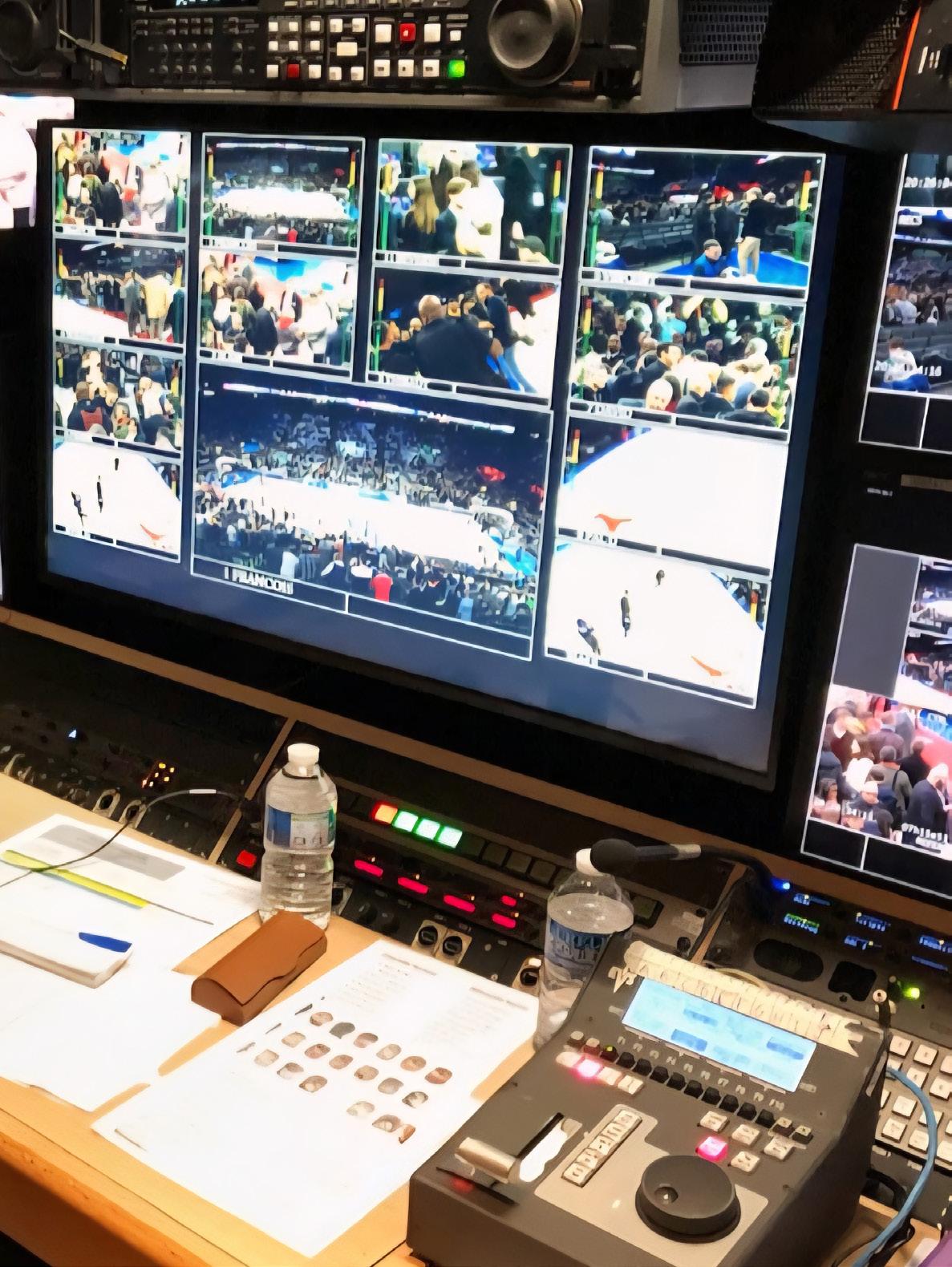
Phoenix, 52, isn’t playing on the same hardwood with Joel Embiid, Jayson Tatum, Shai Gilgeous-Alexander or any other NBA stars.
Instead, he is in his 12th season on the NBA’s Replay Center team, which became part of game operations in 2014 and plays a major role in getting referees’ decisions correct. Phoenix serves as a replay manager.
“Just still being actively involved in basketball, seeing all the different styles,” is the best part of his job, Phoenix said last month from his home in Woodbury Heights. “I like seeing teams that weren’t really good when I started the job – like Oklahoma City – get better and now have won a championship.”
Phoenix and his replay-team colleagues watch two or three NBA games at a time. When a challenge is triggered, Phoenix and a referee who is working in Secaucus, N.J., that night will review the video of the play in question.
“We discuss what was called compared to what we see,” said Phoenix, who, before starting his current gig, played professional basketball in nine countries until 2006 and then spent seven years coaching in college. “And then we have an executive manager there who will basically confirm [or disagree with] what the call is, and then I send it [the video] to the game” for a referee to look it over.
The on-court referee [crew chief] has the final say, Phoenix said, but he/she generally sides with the decision made by the three workers in Secaucus. “If I had to put a number on it, I’d say 98 percent of the time” they concur with his group’s decision, he said.
The state-of-the-art NBA Replay Center is connected to all of the league’s arenas and is equipped with more than 100 HD monitors. The center has 23 workstations that are used by replay operators or replay managers. There are four NBA referees who rotate at the replay center.
Think of the Replay Center team as the fourth referee in an NBA game.
Operators at the center quickly find and send video clips from many
angles back to the referees on the court. The clips have many different angles, and the referees review them.
Those at the Replay Center typically handle a large number of reviews, such as possessions on close out-of-bounds plays, 24-second-clock violations, flagrant fouls, and long shots that are on the border of being two or three pointers. The latter type of review accounts for more than a third of the replays in question. Another popular review: determining whether a shot was released before the buzzer at the end of a period.
Most challenges – a team must have a timeout remaining to make one – are resolved in 30 seconds or less, but a few take an interminable amount of time.
No matter how long a review takes, an accurate decision is the overwhelming result. An NBA Replay Center official estimated that of the approximately 2,200 calls that are reviewed each year, only two or three end up incorrect at the end of the process.
The biggest challenge, Phoenix said, is when one of his assigned games has several calls that are challenged.
“Sometimes, it never stops,” he said. “You go from one replay to the next replay to the next replay. You’re not watching basketball like you would as a fan, as you did when you were growing up. You’re watching it for the thing that possibly can be replayed.”
Does he miss watching the game as a fan?
“This is Year 12 for me, so you kind of get used to it,” he said. “But there are a lot of times when you have a day off and you don’t watch a lot of basketball. You have to do that [get away from it] in order to be fresh for the next time you’re in.”.
Away from his high-pressure job, Phoenix travels in the offseason and spends a lot of his summer on the golf course. Frequently, Jim Crawford, his legendary high school coach, is part of his foursome.
“You can really judge a person by how they are on the course,” Crawford
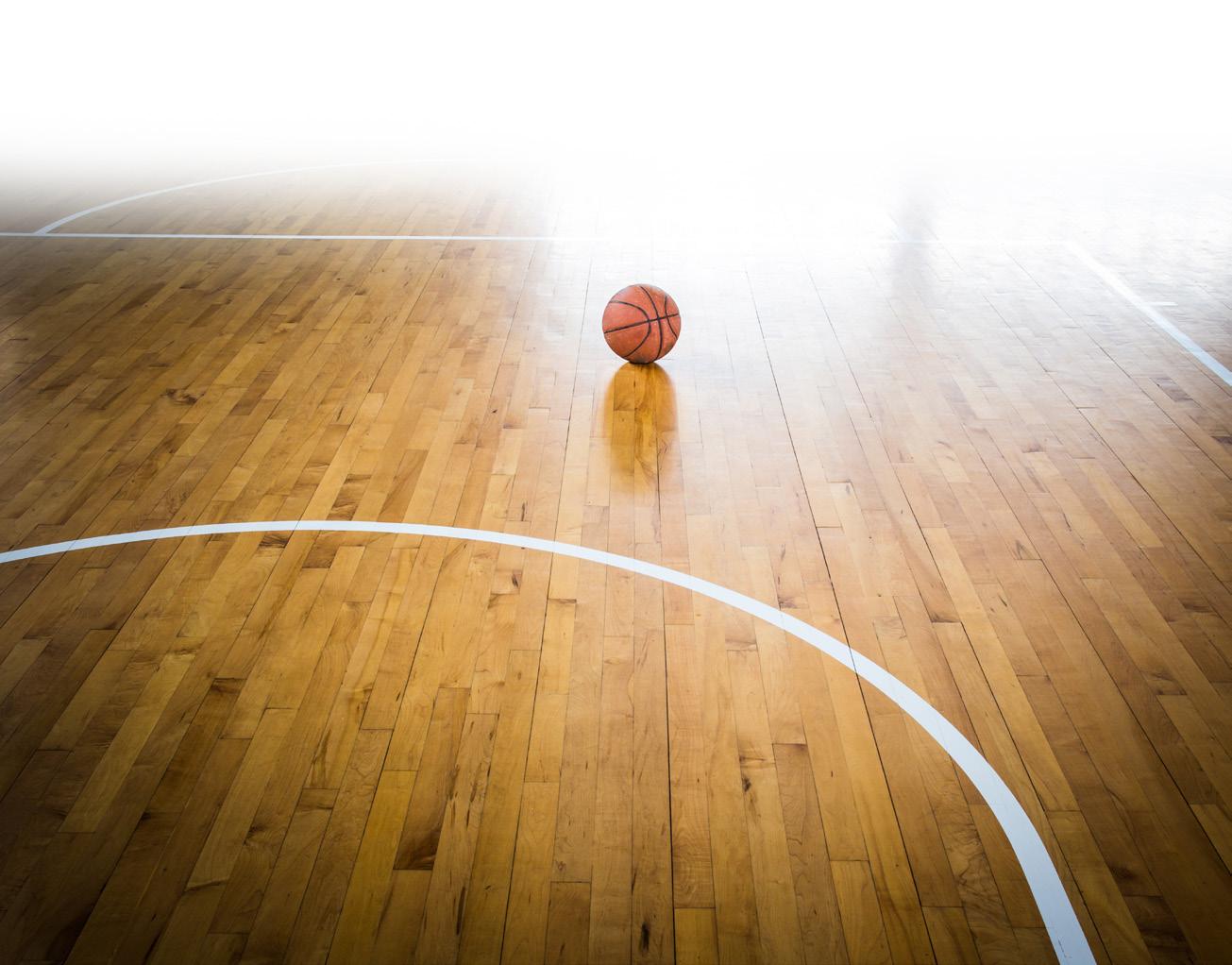
An NBA Replay Center official estimated that of the approximately 2,200 calls that are reviewed each year, only two or three end up incorrect at the end of the process.


said. “He doesn’t get upset about bad shots and he’s just a nice person who was brought up by a nice family. He is always so courteous. On any holiday, there’s a text from him, wishing you well or a happy Father’s Day. That’s the type of person he is.”
Phoenix is a basketball lifer.
At Camden Catholic, Phoenix kept improving. And kept growing. During his teen years, he also played in the highly competitive Sonny Hill League in Philadelphia and became a standout at Camden Catholic, a South Jersey powerhouse.
“You could see early that he had a lot of ability,” said Crawford, who now assists his son, Matt, at Camden Catholic, where Jim has coached for 51 years, “and he kept getting better and better.”
It helped that he had grown to 6 feet, 8 inches.
“He had to fit in with the group in front of him,” Crawford recalled. “The group in front of him was very strong, with Will Walker and the likes of those guys who graduated in ’91. Justin was ’92. By the end of his junior year, Justin took off and then the offers started coming in from the St. Joe’s and the Manhattan’s and so forth. It was a nice process watching him get recruited and it was great following his career at Manhattan. He had a phenomenal career up there.”
At Manhattan, Phoenix played four years and helped the Jaspers make two NCAA Tournament appearances. He became the team’s captain, averaged 12.1 points per game as a senior, and made the all-Metropolitan All-Star team. Phoenix then had tryouts with the Boston Celtics and 76ers. When he didn’t make those teams, he headed to Europe, starting a journey in which he played for teams in England, South Korea, Japan, Indonesia, the Dominican Republic, Spain, Germany, Italy and Scotland, learning different styles that he later integrated into his coaching.
“I think I was able to last so long in all those countries because Coach Crawford taught us the game and Coach Fran [Fraschilla at Manhattan] elevated that teaching – and then you use that to be a good coach yourself,” Phoenix said.
From 2007 to 2014, Phoenix started Phase 2 of his versatile basketball career: coaching. During that time, he coached the men’s team as an assistant at Burlington County Community College, and was a women’s assistant at Kean University and Georgia Southern, and the women’s head coach at Centenary.
All of which led Phoenix to his current job with the NBA. He joined the NBA when the replay operation started in 2014.
When he applied for the position, NBA execs were impressed with his resume.
“I just got let go of my coaching job at Georgia Southern, and I was still looking to stay involved in the game,” said Phoenix, who has also found time to help coach for Camden Catholic and for his niece’s youth team in West Deptford. “I came across the NBA (job) and applied. They had criteria, and I fit three of the four categories – player, coach, and (involved with) high-level basketball. The only thing I didn’t do was referee.”
Ironically, when Phoenix went for his interview to work on replays, the NBA had another idea.
“They wanted me to be a referee and not do replay,” he said. “But my body was still beat up from playing, I told him there was no way. And he just asked me a few questions and read the resume. A lot of the machines we use, I had used in college, so it was an easy transition for me.”
As for the future, Phoenix hasn’t ruled out returning to coaching. If
he ever returns, he has “learned another aspect of the game. You learn where the referees are supposed to be, what they’re supposed to be looking at. So you know more about officiating than when you were playing.”
He said, “If the right opportunity came, I would definitely pursue it. I loved coaching and helping kids get better, whether they’re male or female.”
Phoenix is one of the lucky ones, enjoying a job that revolves around his passion – basketball. It was a passion that developed when he was first taught the game in Williamstown by his youth coach, his dad, Arno. His dad also took him to his initial NBA game: the 76ers vs. the Boston Celtics at the venerable Spectrum. Julius Erving against Larry Bird. Dr. J vs. Larry Legend.
He has fond memories of that long-ago night.
“I was in second grade, and I liked the color green,” Phoenix said with a smile. “And I’m cheering for the green team.”
That, of course, was the Celtics.
“My dad looked at me and said, ‘If you don’t stop, we’re not going to make it out of here alive,” Phoenix said. “So, I just stopped, and I cheered for both teams. And it came full circle years later because the first teams I got to work out for were Boston and Philly. That’s pretty cool for all that to happen.”
And pretty cool that – 45 years after he watched Bird, Erving and the rest of the players who were part of one of the NBA’s greatest rivalries –he’s still connected to the sport he loves. n
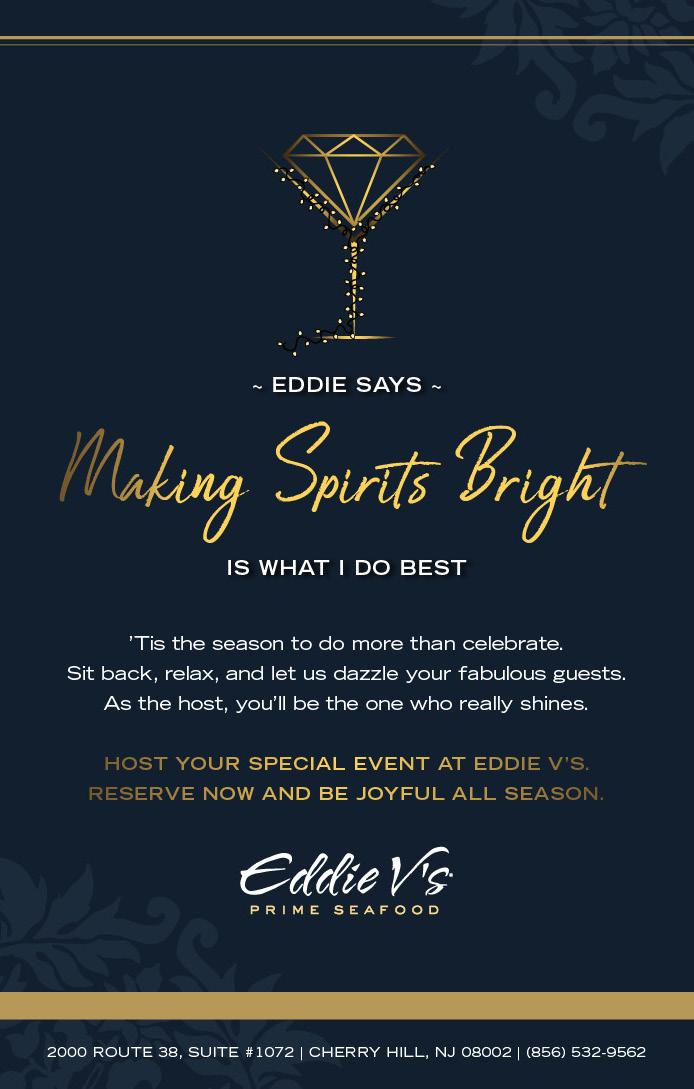




BY KURT SMITH
In just three years in the cigar business, Kingmakers Cigars already has celebrity partnerships, top-quality ratings, and bigger things on the horizon. JerseyMan caught up with Bucky Heath, the founder and CEO of Kingmakers, to discuss their dedication to excellence and its rewards.


“Do you know what I invest in? Excellence.”
– Eddie Felson, The Color of Money
IF YOU CAN SCORE Carmelo Anthony to be associated with your brand, you’re doing something right. As his career numbers show, he’s clearly not someone who settles for mediocrity. Kingmakers Cigars made it happen. Their VERSA VII (the “E” is actually backwards) cigar portfolio is Anthony’s brand. According to Kingmakers CEO Bucky Heath, Melo is bringing a box to his NBA Hall of Fame induction.
The VERSA VII, says Heath, is “the perfect smoke to honor a legendary career.”
Heath isn’t being boastful. Well, maybe he is a little, but it’s certainly justifiable. You can, though, easily tell from his demeanor that he’s humbled to be in this venture, around a team that can construct a cigar worthy of an NBA Hall of Famer’s approval.
The Kingmakers’ name, he explains, is about celebrating excellence and achievement.
“We built this brand to tell other people’s stories. We’re Kingmakers in the sense of, not in an arrogant way, but in how you sit down and enjoy whatever it may be in your life. You celebrate those moments, whether it’s signing a deal, the birth of a child, whether it’s a big win in a game or a championship.
“This is your moment in life. You need to reflect upon it. We want people to really enjoy that moment. The cigar itself is an accessory. It’s the instrument for you to enjoy that moment.”
He calls Anthony a “true King,” but Kingmakers has made connections with other big names, like two-time WNBA champion and Team USA gold medalist Kelsey Plum, the first female athlete to have her own signature cigar line. In addition to her cigar collection, Kingmakers and Under Armour, with Humidif Group, created the “Shoemidor” for Plum, a custom humidor that neatly houses both cigars and sneakers.
Even though the name is Kingmakers, Heath says the Plum partnership is “a massive state-

ment designed to shatter old stereotypes.”
“Appreciation for a premium cigar has nothing to do with gender, and everything to do with celebrating excellence.”
KINGMAKERS features cigar lines from established musicians, too, including JJ Julius Son from the blues rock band Kaleo, and country music artists Midland. JJ and the Midland boys are also passionate cigar enthusiasts, and like with Plum and Anthony, there was a detailed process to getting the product right.
“It’s definitely not just slapping a name on a box,” Heath explains. “We sit down with
them to talk about their tastes. What cigars do they love? What flavors do they gravitate towards—bold and spicy, or smooth and creamy?
“Our master blenders create several sample blends based on that conversation. The celebrity partner will test those samples and provide detailed feedback. ‘I like the spice in Blend A, but can we get the creaminess of Blend C in there?’ This can go on for multiple rounds until we nail the perfect profile.
“The goal is for the final product to be a genuine reflection of their personal brand and palate.”
“Our partnerships are built on authenticity,” Heath continues. “We don’t just look for fa-



“We didn’t just want to sell cigars; we wanted to build a brand that people felt a part of.”
mous faces. We look for people who genuinely embody the Kingmakers ethos of excellence, passion, and a love for the lifestyle.”
In that vein, Kingmakers is nailing down partnerships with more big names. There are major brand connections in the works that Bucky appears to be dying to talk about, but the ink isn’t quite dry yet.
With all that said, even Kingmakers’ brands without the celebrity name tag do pretty well. The Persona No. 1, which Heath refers to as “the bedrock of our brand,” recently received a 93 rating from Cigar & Spirits Magazine
Not too shabby for just three years in the business.
BUCKY HEATH has always enjoyed cigars and has always seen them as a way to celebrate a moment.
He worked for years in Major League Baseball, first in the ticketing realm and then later booking talent for events and pre-game shows. While in the sports and entertainment space, he became friends with multiple entertainers and managers.
After 20-odd years in the business, he got to know Claudio Torres, a long-established tobacco industry veteran. With Claudio, Bucky saw an opportunity to pour his enthusiasm for a premium cigar … and its associated moments … into a new addition to an established industry.
Claudio, the co-founder and COO of Kingmakers, “is the brains behind the blends,” according to Heath. “He works with all of the master blenders. He had a vision from the beginning of how to curate a fine experience.
“Claudio’s been in the industry for over 25 years. Cigars are in his DNA. His family has been in the tobacco business for generations, so he grew up with a deep, authentic

The humidor is an essential accessory for any cigar enthusiast. It protects your collection from drying out or from moisture and preserves the cigars’ flavor and structural integrity.
Kingmakers decided to elevate the humidor, in their partnership with Kelsey Plum, with a new kind of humidor: the “Shoemidor”. It’s a humidor designed not just to protect cigars, but also the basketball star’s most important accessory: sneakers.
According to the Kingmakers website, the Shoemidor was handcrafted in Estelí, Nicaragua, by Humidif Group Cigar Box Factory. They describe the Shoemidor as “precision engineered with the finest wood, optimal humidity control, and a design that seamlessly blended sneaker culture with luxury craftsmanship.”
Heath is especially enthusiastic about this inspired innovation.
“The Shoemidor is a project we’re incredibly proud of. We originally designed it for Kelsey Plum as part of a major partnership with Under Armour for her 2024 ‘All the Smoke’ signature shoe.
“The concept of a luxury humidor shaped like a sneaker box—holding both her custom shoes and signature cigars—was an incredible project that blew up. It was even featured live on primetime via ESPN and other networks, which was an amazing moment for us. It perfectly captures that fusion of sneaker culture and cigar culture.”
He sees great potential in the Shoemidor, as he should.
“We’re now in the works with our next line of athletes to create custom Shoemidors, to fit their own shoes and signature cigars as well.”
So, if you’re an athlete yourself, consider having your own Shoemidor someday.





understanding of what makes a truly exceptional cigar.”
The two brainstormed a well-defined vision to create an exceptional cigar brand. As Heath puts it, the goal wasn’t to change the industry, but to add to it.
“My first approach to Claudio was, let’s create a private label cigar manufacturing and distribution company. Let’s go to my contacts in the industry, and let’s build a really sexy, cool, different brand.
“We did not start this to take market share from any manufacturers that are currently in the space. We came to grow and expand it into a new kind of youthful brand that is leveraging athletes and musicians who truly care and want to be a part of this.”
“We’re not a very well-established brand in the sense of the history of these cigar makers,
who have been around for hundreds of years, where their grandparents grew the tobacco and rolled it themselves. We’re not trying to be that brand. We want to honor those individu-
“A cigar forces you to do something we rarely do anymore: slow down. You can’t rush a great cigar.”
als and brands that have built the lane for us.”
One does get the sense that partnerships with the likes of Carmelo Anthony, Kelsey Plum, JJ Julius Son and Midland should help to bridge premium cigar admiration into a new generation.
Today, Kingmakers features eight distinct collections of premium cigars, each with their own style, construction, and backstory. Their website partially describes Carmelo Anthony’s collection thus: “This transformative spirit, of continually turning challenges into conquests, is the essence of VERSA VII.”
DURING HIS INTERVIEW with JerseyMan, Bucky Heath didn’t utter a single complaint about the trials and tribulations of operating a business, which every entrepreneur knows is considerable.
To the contrary, talking with the CEO of Kingmakers, you can feel the contagious enthusiasm he has for everything about the venture and his company’s representation of the




finer things in life.
“I’ve always been very intrigued with the art of a cigar, the making of a cigar, the textures, the layers that go into it, the whole process. It’s really, really amazing, the art that goes into it.”
He adds, “A cigar forces you to do something we rarely do anymore: slow down. You can’t rush a great cigar. It requires you to be present, to reflect, and to savor the moment.”
Whatever the milestone, Heath says, “a cigar becomes the punctuation mark for that achievement.”
“We didn’t just want to sell cigars; we wanted to build a brand that people felt a part of. Seeing people from all walks of life—entrepreneurs, athletes, artists, men and women—celebrating their personal ‘wins’ with one of our cigars is the ultimate reward.”
IT HELPS that Heath and company have celebrated some very special moments of their own with a Kingmakers smoke.
“I have to pinch myself every day to say, ‘Is this real life?’ I’m a big sports and music fan. I love Philadelphia sports. I bleed green. In October, it’s red only. I’m Philadelphia all the way through.
“Unfortunately, we lost, but Kingmakers was in the locker room, ready to be celebrated two years ago when the Phillies lost to the Diamondbacks. (Diamondbacks first baseman) Christian Walker was nice enough to bring in Kingmakers cigars into his locker room. It was bittersweet, I’m not going to lie.
“I went to the game and watched Kelsey receive her ring for back-to-back championships. They did a whole thing on ESPN on live broadcast about the Shoemidor. Being now with Carmelo, watching him being inducted into the NBA Hall of Fame, and then afterwards, to just sit down and enjoy his cigar with him.
“Being that fly on the wall with these amazing individuals, these artists, being able to celebrate them and be a part of history. Those are the memories that really, to me, matter,” Heath says humbly.
“It’s not about Kingmakers. It’s about watching everybody else enjoy what they do so well in their craft.” n
Even though Bucky Heath showers the credit on Claudio Torres for being a cigar mastermind, he was happy to tell JerseyMan about what makes a cigar stand out. In a most kind act of generosity, he did this writer’s job for the article…you can attribute these quotes directly to him:
“It boils down to three key things: Construction, Flavor, and Balance:
“1) Construction (The Architecture): A great cigar is a work of art before you even light it. It should feel firm but not hard when you gently squeeze it, with no soft spots. The wrapper leaf should be smooth, oily, and free of any major blemishes or tears. A wellconstructed cigar will burn evenly and have a smooth, easy draw.

“2) Flavor (The Journey): A great cigar isn’t one-note. It takes you on a journey. The flavors should be rich and distinct, but also complex. You might start with notes of cedar or earth, which then transition to coffee, cocoa, leather, or a bit of spice. The magic is in how these flavors evolve and interact as you smoke.
“3) Balance (The Harmony): This is the secret sauce. Balance is when all the different tobaccos in the blend (the filler, binder, and wrapper) work together in perfect harmony. No single flavor is screaming for attention or overpowering the others. It’s a smooth, cohesive, and enjoyable experience from start to finish.”
Heath can also expound on the merits of where the tobacco is grown.
“The soil, the amount of sunlight, the humidity, and even the local traditions for curing and fermenting the leaves have a massive impact on the final flavor.
• “Nicaraguan tobacco is famous for being bold, spicy, and complex. The volcanic soil there is incredibly rich.
• “Dominican tobacco is often known for being a bit smoother, creamier, and more nuanced.
• “Ecuadorian tobacco is prized for its wrapper leaves. The consistent cloud cover acts like a natural filter, producing thin, silky, and flavorful wrappers.”
He continues with how a novice can become an aficionado…through experience.
“It’s all about ‘palate training’. By smoking cigars from different regions, you start to recognize those signature flavor profiles. You might notice the ‘Nicaraguan spice’ on the back of your tongue or the ‘Dominican creaminess’ in the smoke’s texture.”
Of course, it’s still a matter of individual taste.
www.kingmakerscigars.com
“Ultimately, the ‘best’ cigar is the one you enjoy the most. Start by trying different things and paying attention to what you like.”

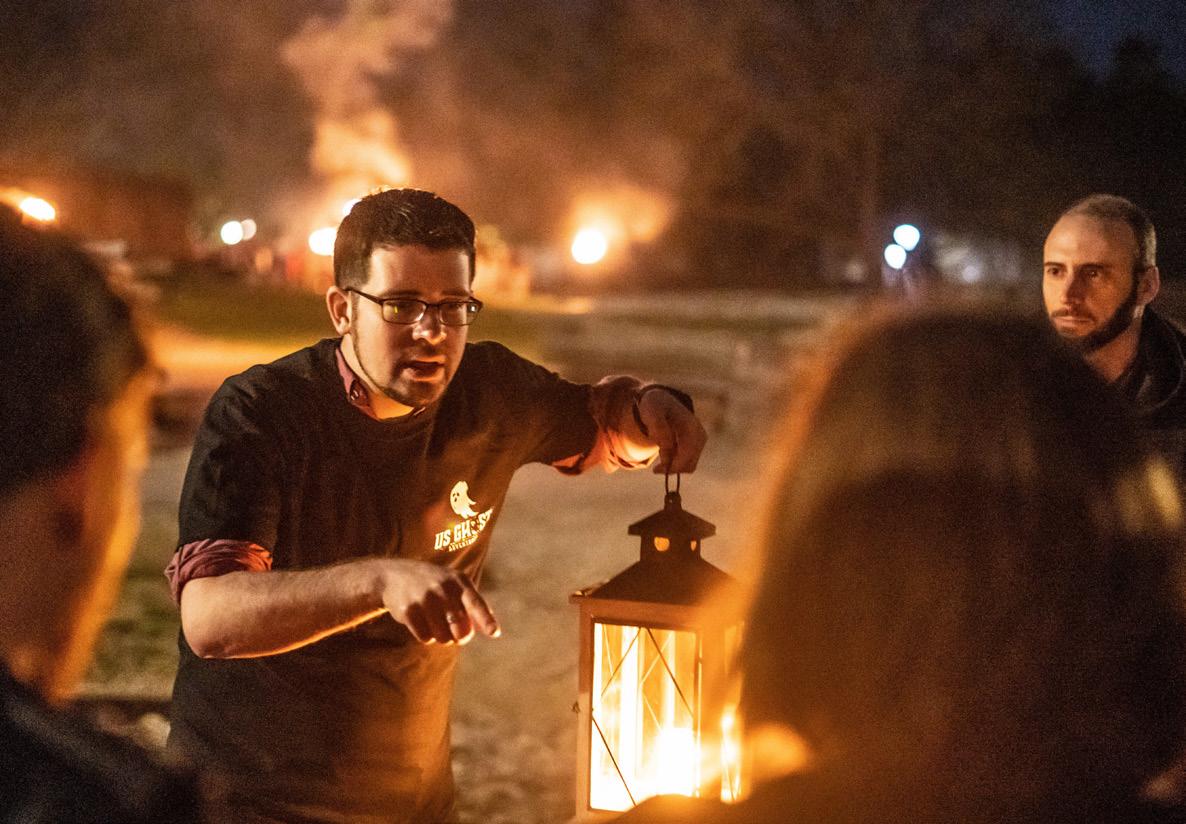
BY JAN L. APPLE
US Ghost Adventures
usghostadvantures.com • 816-722-7363
This organization sponsors haunted ghost tours in 100 cities across the country. In our region, such tours are offered in Atlantic City and Old City Philadelphia. All tours are described as kid-friendly with ghost stories that are ageappropriate for the whole family.
Tickets for both locations: $26 adults; $17 for children under 13. Advance Bookings Recommended
The Paranormal Museum
Paranormal Books and Curiosities, 621 Cookman Ave., Asbury Park, NJ 732-455-3188 • www.paranormalbooksnj.com
Enter this popular Asbury Park Museum and bookstore and learn about the history and intrigue of the paranormal and much more. The museum, established in 2008, features an array of unique and mysterious artifacts from haunted places and a collection of items, such as Ouija boards and eerie dolls. Visitors to the museum step inside a supernatural world and explore the paranormal. And the walking ghost tours (offered Thursday through Sunday evenings) held through mid-November, fill up quickly. The tours relay true stories that took place on the town’s infamous boardwalk.
According to owner Kathy Kelly, the museum was the first of its kind to open in the country. She recently opened another location in Cape Cod with coowner Adam Berry.

Are you seeking a bonechilling ghost tour? A walk through a haunted house? A visit with goblins or skeletons? Or perhaps you simply aspire to enjoy an array of Halloween festivities. Options abound throughout the region. Here are just a few from which to choose.

“Our popularity comes from our longevity and authenticity,” said Kelly of the Asbury Park destination. “People connect with what we do because we are fully invested in creating an authentic and approachable experience. In addition, we take the subject seriously, but not ourselves, so it’s also fun. Paranormal is a tent pole in Asbury Park, a must-visit location because we are stitched into the fabric of the community.” Kelly elaborated that their ghost tours are grounded in history (actual events from the past) and first-hand experiences. “People continue to have and share their paranormal experiences, which add to and change our tours.”
Other upcoming events include the annual Jersey Devil Fable Festival, beginning on October 10 with the Jersey Devil Film Festival and continuing through October 11 with a street festival on Mattison Ave.
Ghost Tour Tickets: $25 for adults; $20 per child (under 12). Advance Bookings Recommended. For more information on booking a museum or ghost tour, visit https://paranormalbooksnj.com.
Aces to Ashes: Apparitions of Atlantic City Boardwalk Ghost Tour
Meet at Rainforest Café, 2201 Boardwalk, Atlantic City, NJ 08401
Walking tours are held nightly year-round at 8 p.m. and last for one hour. Guests meet outside the Rainforest Café on the boardwalk and visit multiple locations, including the Warner Theatre, Caesar’s Atlantic City and Bally’s Casino. The venue’s website describes Atlantic City Ghosts as “an authentic, chilling experience that strives to make sense of the unexplainable.” Based on realworld portrayals of hauntings and well-documented history, it is said that participants are sure to have a once-in-a-lifetime chilling experience. For information or to book a tour, visit www.usghostadventures.com/atlanticcity-ghost-tour/
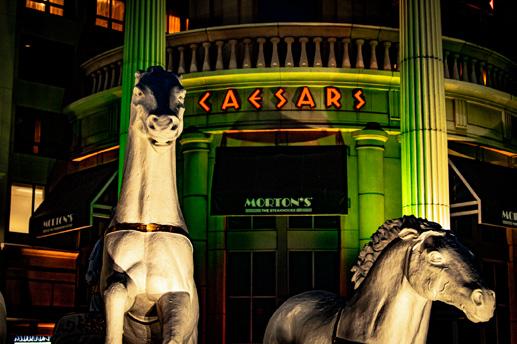
Philly Ghosts Phantoms of Philadelphia Tour
Meet at Tomb of the Unknown Soldier Washington Square Park, 217-231 W Washington Square, Philadelphia, PA
Haunted ghost tours are held nightly year-round and take guests through historic landmarks said to be steeped in grief and despair. The one-hour tours begin at 7 p.m., 8 p.m. and 9 p.m. The tour takes guests through the historic area and landmarks in the City of Brotherly Love. There’s also a haunted pub crawl.


According to Jandie A., a senior support specialist with U.S Ghost Adventures, “in both Atlantic City and Philadelphia, guests will hear captivating ghost stories from the city’s best local guides as they share tales of notorious spirits and eerie hauntings. They will stroll through haunted city streets after dark and uncover local legends from infamous witch trials to little-known tragedies, murders and scandalous events.”
For information, www.usghostadventures.com/philadelphia-ghost-tour.
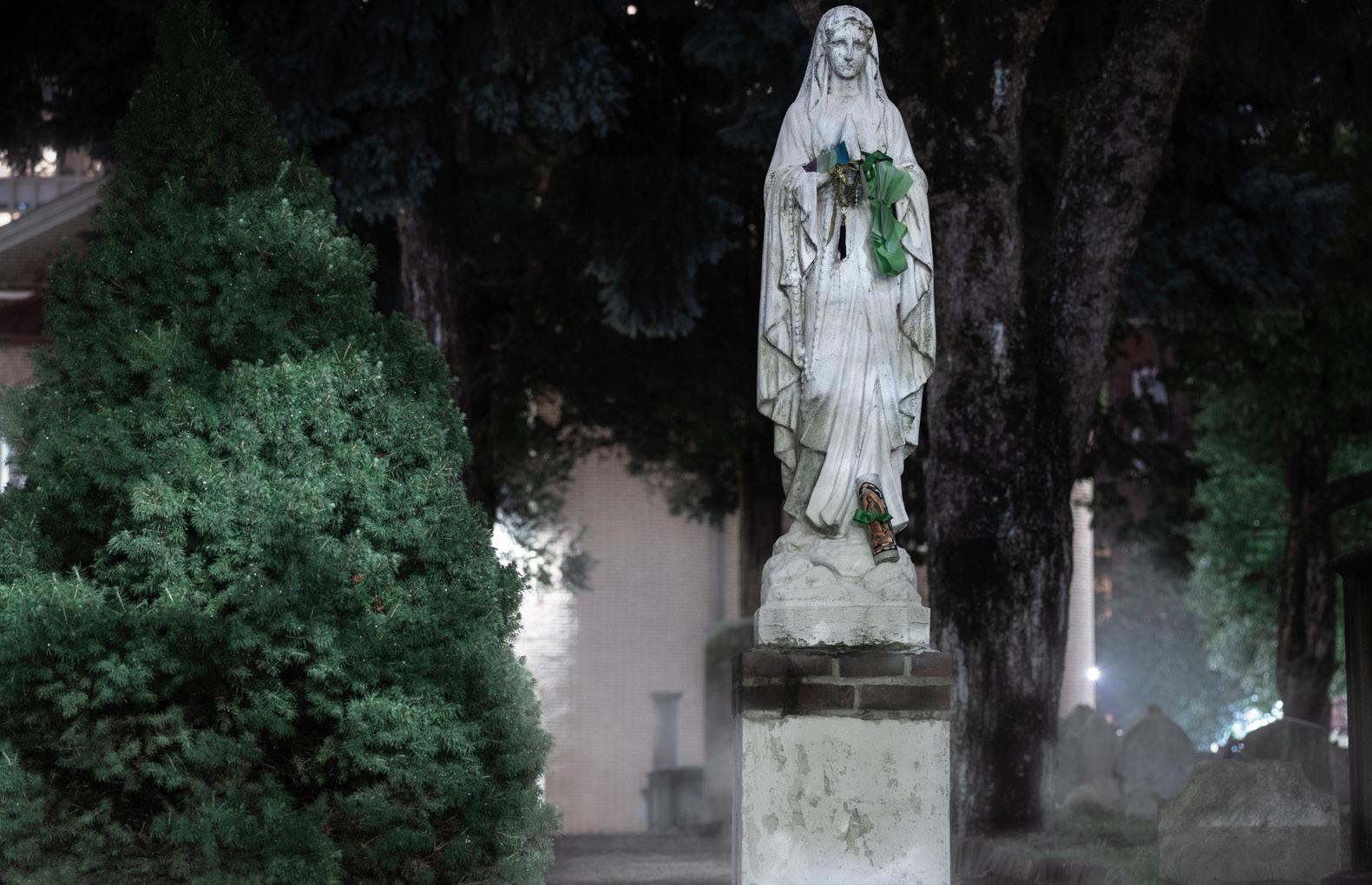
Haddonfield Historical Society
Greenfield Hall, 343 Kings Highway East, Haddonfield, NJ 08033 856-429-7375• www.haddonfieldhistory.org
A local favorite and back by popular demand, the Haunted Haddonfield walking tours will be offered again on the following Fridays and Saturdays: October 10 and 11, 17 and 18 and 24 and 25. Tours start at 7 p.m. and participants meet outside Greenfield Hall. Groups are capped at 40 people and walk through the Baptist Church cemetery.
The one-hour tours are based on the stories in author William Meehan Jr.’s two volumes of “Haunted Haddonfield.” Many of the stories are from the lives of deceased Haddonfield residents. Some have been passed down through generations of families.

According to the historical society’s Board of Trustees, “Bill was an accomplished researcher, writer, and public speaker with several published books and magazine articles. He sadly passed away in December 2021 after a long illness. With the blessing of his family, we have continued the Haunted Haddonfield walking tours that he led for over 20 years. We are forever grateful for his generosity.”
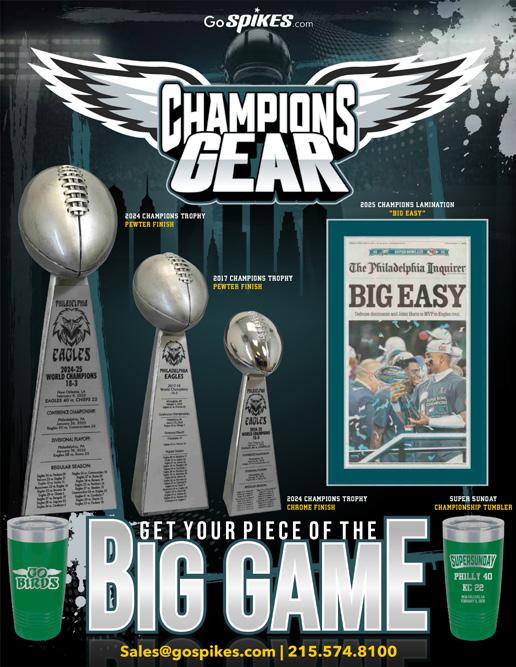
Tickets can be purchased online at www.haddonfieldhistory.org or through the historical society’s office. Price is $20 for adults and $15 for children 12 and under. It is suggested that participants bring flashlights and wear comfortable shoes. Each walking tour has a limited number of participants, so those interested are encouraged to register in advance. Private tours can also be arranged ahead of time.
Creamy Acres Farm, 448 Lincoln Mill Road, Mullica Hill, NJ 856-223-1669 • www.nightofterror.com


Night of Terror at this Mullica Hill farm is considered one of the Northeast region’s scariest Halloween destinations. This 100-acre complex features half a dozen bone-chilling attractions where visitors will come face-to-face with zombies, attack dogs, chainsawwielding maniacs and killer clowns. There’s also the sought-after haunted paintball hayride.
HGTV named Night of Terror as one of the scariest destinations for haunted houses in the Northeast, second only to the event in Salem, Massachusetts, home to the famous witch trials of the 1690s. And the Ride of Terror has been described as the best haunted hayride in the Garden State. Night of Terror is offered on weekend nights and more through October. Visit www.nightofterror.com for specific times, prices and to purchase tickets.


Eastern State Penitentiary Historic Site
2027 Fairmount Avenue, Philadelphia, PA 19130 (215) 236-3300 • www.halloweennights.org
INSIDE THE WALLS of this once-operational 10-acre prison, a National Historic Landmark, those seeking the thrill of fright can find it during the wildly popular Halloween Nights. Described as a “Halloween Festival of Epic Proportions,” the event was totally reimagined in 2021 and introduces new features each year.
Offered on select evenings through November 8, Halloween Nights features five haunted houses, live entertainment, themed bars and tours of the longabandoned cell blocks and yards. Haunted houses include Delirium, Big Top Terror, Machine Shop, Nightmares and The Crypt.
“Each season of Halloween Nights is the result of months of creativity, planning and innovation, and every year we push ourselves to go further,” said Erin Davis, director of Halloween Nights. “For 2025, we’ve raised the stakes once again with Dark Tides and Apocalypse Pass, two all new experiences that redefine the scale and intensity of the festival.”
In addition, this year’s event showcases expanded food and beverage offerings, a redesigned event flow and enhanced sets and characters. “This year’s event will deliver our most immersive, cinematic and unforgettable Halloween Nights yet,” said Davis. “From the moment visitors step through Eastern State’s front gate, they’ll be transported into a world of spectacle and surprise.”
For those intrigued with the past and the storied criminals that once occupied


the former prison, award-winning exhibits include those about mass incarceration and its history in the United States. There’s also an audio tour, “The Voices of Eastern State,” featuring the voices of people who were incarcerated at the prison and those who worked there.
The penitentiary, with vaulted, skylit cells, closed as an active prison in 1971. According to easternstate.org, the prison, “known for its grand architecture and strict discipline, was the world’s first penitentiary, designed to inspire penitence, or true regret in the hearts of prisoners.” Eastern State imprisoned nearly 85,000 inmates in its long history, including “Scarface” Al Capone and “Slick Willie” Sutton.
According to their website, proceeds from Halloween Nights ticket sales will support the “preservation of Eastern State and their mission to preserve America’s first penitentiary, advancing public understanding of the criminal justice system.”
For information or to purchase tickets, visit www.halloweennights.org
Learn more about Eastern State Penitentiary at www.easternstate.org n
Information on other haunted, bone-chilling and Halloween-related regional events can be found at www.visitnj.org and www.visitphilly.com


We are proud to introduce you to our private business network
H Do you want to expand your network in Philadelphia and South Jersey?
H Do you want to create powerful connections with other business professionals in the area?
H Do you want to attend exclusive networking events twice per month at local venues?


Martin H. Abo Abo and Company, LLC
Ross Akselrad Pulse Entertainment/Productions
Alexis Allegretto Surety Title Company
Joe Allen Sonitrol
Chris Ambruch Alcom Printing
James Andreacci OceanFirst Bank
Joel Ardman Carroll Engineering
Liz Arking Weichert Premier*
Bob Arnold SeatonHill Partners LP
Keith Asplundh Asplundh
Suzanne Aumack AUMOST Creative Group
Keith Baldwin Spike’s Trophies & Awards
Ed Barlow III Barlow Auto Group
Michael Barreto Metropolis Passenger Logistics
Catherine C. Barrett Cat’s Mobile Massage, LLC
Brian Barry Keller Williams Cherry Hill
Robert Beach Procision Commercial Realty & Procision Business Brokers
Robert Bender The First National Bank of Elmer
Tom Bentey Suburbanite Productions
Manny Bermudez Citizens Bank
Tom Bernetich BDO USA, LLP
Harry Bickel Precision Benefits Group
Brian Bielawski Dynamic Advertising Solutions*



Michelle Bishop REAL Broker
Matt Blatz PCS
Christine Blithe ARS Truck & Fleet Service
Ken Bode Integrity Staffing Solutions
Anthony Botte A.M Botte Mechanical, LLC
Jessica Botte A.M Botte Mechanical, LLC
Michael Bowman Valley Forge Tourism & Convention Board
Matthew Boyce Maximus Mortgage Advisors
Kelli Brack Edward Jones Investments
Adam Bracy SSG Executive Advisory Group of Raymond James
Kimberly Bryson Girl Scouts of Central & Southern NJ
William Burris Ristorante Lucca
Taylor Campitelli WeThrivv
Pete Caniglia Engage Media
Louis Cappelli Jr Florio Perrucci Stienhardt Cappelli & Tipton, LLC
Mark Caprarola CapWealth
Carlo Capuano Carlucci’s Waterfront LLC
Marco Carolla Tix For Good
Mike Chapman Tourneau
Jennie Charmley Vanguard
Ryan Chew Fulton Bank N.A.
Rudy Cislak Diversified
Kathleen Citera SHINE Coaching Group, LLC
Geoff Cleveland Capri Wealth Management
Jon Cofsky whitepenny
Justin Colantonio Total Technology Resources
Cheryl Colleluori HEADstrong Foundation Mike Commisso Docutrend, Inc.
Joseph J. Console Console Matison LLP
Trevor Cooney Archer & Greiner P.C.* James Corbett Project Refit
Peter Cordua Cordua Consulting, LLC
William Cornelius M&T Bank
Bill Crowe Maryville Integrated Care
John Cruice John Cruice Photography
Pat Curiale First American Title
Rob Curley TD Bank
Bill D’Ambrosio Verde Payments
Benjamin Dash DashLaw LLP
Dustin Davis CaptiveResources
Justin Deal PayDay Employer Solutions*
David Debreceni Edward Jones
Anthony DeGerolamo DeGerolamo Financial Strategies
Jack Delaney Rarity Real Estate
Rob Dennis JDog Junk Removal & Hauling
Gary DeVito Zarwin Baum Devito Kaplan Schaer Toddy, P.C.
Kevin Diduch KD Law Group*
David Dieal BASH Capital
Joey Dill Paychex Payroll & HR Solutions
Devin DiNofa Keller Williams Real Estate


Lia Domenick Allstate
Bob Doria Medford Village Country Club
Victoria Draper Travel with Pam Draper
Kevin Duffy Committed to Capital
Ken Dunek New Opportunity Publishing
Doug Easlick Graham Company
Donald Eichman Alcom Printing Group
Bill Emerson Emerson Group
Will Emerson Emerson Group
Ryan Esposito Constellation Brands
Bill Evans Liberty Fox Technologies
Dave Evans BOWMAN & CO, LLP
Kenneth Fairchild Jersey Nutz Charters LLC
Allison Farcus AssuredPartners
Gary Farnesi WSFS Bank
Mark Fisher Fisher Financial Management
Jerry Flanagan JDog Brands
Sean Flanagan Always A Good Sign
Stephen Flanagan JDog Carpet Cleaning
Steve Foreman Financial Business Systems, Inc.
Corinne Franceschina Jaws Youth Playbook
Rachel Frkovich Workplace HCM, Inc.
Mike Fuller Maggianos
Dennis Gallagher Hire Entry
Joe Gangemi Suite Recording
Mumta Gangwani GT Media LLC
Denise Gardner DeGerolamo Financial Strategies
Tom Gee Palo Alto Networks
Robert Gelsher Janney Montgomery Scott LLC
Damien Ghee TD Bank
Jim Gibson Alcom Printing
Dave Gill Haefele, Flanagan & Co., P.C.
Robert Glycenfer Financial Guide
Mark Godofsky Surety Title Company
Michelle Gollapalli Food For The Poor
Steve Goodman Greater Philadelphia YMCA
John Gordy Blue Hen Capital
Liz Green Richard Green & Son Public Adjusters
Jen Groover Thuzio
Dr. Thanuja Hamilton Advocare Sleep Physicians of South Jersey
Steve Hanscom CBRE
Joe Hassan MPI Valuation & Advisory
Pete Hatton Hutchison Mechanical Services
Chef Jose Hernandez The Catering Station, Inc.
Robert Hoey Janney Montgomery Scott
Robert Hoey, Jr Janney Montgomery Scott
Kirstie Holmes Pegasus Financial Planning
Michael Holt Holt, McNally & Associates
Hope Feldscher Horwitz Feldscher Horwitz Public Relations
Cheryl Houtz The Benefit Doctor
Nichole Howard Nichole MCH Photography
Kristi Howell Burlington County Chamber of Commerce
Stephen Hruby, Jr Patriot Landscaping Services
Edward Hutchinson Hutchinson Mechanical Services
Katie Interrante Apex Commercial Capital
Tim Irons T.C. Irons Insurance
Mike Jaconelli Tam Lending
Ron Jaworski Ron Jaworski Golf
Timothy Jennings Telecorp
Chris Jerjian Kiwi Offices
Keith Johnson Laurel Lanes
Jessica Jones Simplifi Payroll & HR
Kenneth Justice KMJ INC.
Niki Kahn Drybar Mount Laurel & Drybar Marlton
Jon Katz Bestwork Industries for the Blind
“I simply cannot say enough about how wonderful and gratifying joining the Legacy Club has been for me and my business. I have had the privilege and pleasure of connecting with an amazing group of like minded entrepreneurs. Through these connections and networking events, I have watched my business grow to a level I could have only dreamed of. If you want to grow your clientele, expand your network or just have a place where you’ll be met with love, drive and equal ambition, The Legacy Club is your next home.”
– Cat Barrett Cat’s Mobile Massage, LLC

Corey Katzen Nirvana
Keith Keller SpeedPro South Jersey
Bob Kennedy Insperity*
Robert Kennedy The Kennedy Companies
Erica Kirk North Star Leasing*
Damon Kline Remington & Vernick Engineers
George Koch SoundPlex
Daniel Kochka Integrated Accounting Solutions
Anne Koons BHHS Fox & Roach, NJ/PA & Vineland Construction Co.
David Kryszczak Spartan Digital Solutions
Edward Labman Univest
Joe LaGrossa Intellicor
David Lance Pristinex
Keith Langan Surety Title Company
Bryan Levens SNEVEL Technologies, LLC
Brian Libby Primepoint
Robert Lipinkski Cherry Hill Cigar Club
John Lorenzo TwoTwo Creative
Eric Lottes DelVal Techs
Eric Lynn Northbound Strategies
Joey Mac Dizon The Mobile Cigar Lounge
Chris Maciborski Weisman Children’s Hospital & Voorhees Pediatric Facility
Anton Makharynets ANTVAL Rentals
Joseph Mancini TriState Engineering & Surveying
Jason Mancivalano JP Morgan Private Bank
Tom Matera AnnieMac Home Mortgage
Betty Maul FrontEnd Graphics
Matthew McDevitt Positive Wiring
Ty McGilberry Pegasus Financial Planning
Candy McMullen C&S Workforce Consulting Group
Anita Meeks Allure Payments
Carson Merine Keller Williams Realty
Frank Messina AllRisk Property Damage Experts
Jeremy Messler Jeremy Messler Photography, LLC
Marla Meyers Legacy Treatment Services Foundation
Brian Minker Able Technology Partners, LLC
Anthony Minniti Camden Apothecary Dispensary at Bell Pharmacy
Justin Mirigliani Checkmates Charitable Association
Samir Mody Keller Engineers of New Jersey*
Anthony Mongeluzo PCS
Ron Monokian We Make It Personal by Joy’s Hallmark
Dan Morroni Morroni Custom Clothiers
Steve Mullen Insperity
Peter Musumeci TD Bank
David A. Navazio Ristorante Lucca
Rick Nelson EOS - Advance to Vision LLC
Chad Niederman K & C Cleaning, LLC
Dan Ninerell Modern Classical Chefs
Joseph Ohlweiler JTO Advisors & TAB SNJ
Marc Oppenheimer Parx Casino
Amy Osborn New Jersey Vietnam Veterans Memorial Foundation
Colette Oswald Colette Oswald Photography
Michael Ott At Home Technology
Richard A. Palko Closet Factory
Rae Pastore Durand, Inc
Deep Patel GenRise Wealth Advisors, LLC
Lee Perlman Law Offices of Lee M. Perlman
Mike Perlow Perlow Productions
Jaime Picozzi GHR Healthcare*
Thyrick Pitts, Jr. Duncan & Associates - Ameriprise Financial LLC
Frank Plum Workplace HMC Inc.
Roy Plummer Armed Forces Heritage Museum
Steve Pontrello Barlow Work Trucks
Andy Pritikin Liberty Lake Day Camp & Special Events
Eileen Propp Prime IV Hydration and Wellness
Geoff Rabinowitz New Balance
Soleiman Raie Lento Law Group
Matt Rakus Paparone Insurance
Syed Hadi Raza Raza’s at Hamilton
Derrick Reagan Innovative Benefit Planning LLC
Lisa Regina A Write to Heal, Inc.
Ryan Regina Big Sky Enterprises, LLC
Robert Richardson Allied Document Solutions and Services, Inc.
Irving Rodriguez Cigar Slingers
Mike Rosiak Weisman Children’s Hospital & Voorhees Pediatric Facility
Seth D. Rotman Clarify Wellness LLC
Andrew Ruhland National HR
Helana Russo Empire Counseling Services

Jawad H. Salah Archer & Greiner, P.C.
Robert Salotto First Financial Lending
Michelle Sapp Arhaus*
Sergio Scuteri Capehart Scatchard, P.A.
Jeremy Shackleford WSFS Bank
Haley Shapiro Eddie V’s Prime Seafood
Hala Shawaf-Barson VoIP Doctors Business Telecommunications
Lee Shields Marcum
Jennifer Sherlock Jenna Communications, LLC
Dr. Joel Shertok Process Industries Consultants
Gary Shickora Northwestern Mutual
Joe Silva HBK CPA’s & Consultants*
Joe Simone Regional Resources Energy Group
Josh Smargiassi Boomerang
Chris Smith Micro Integration Services, Inc.*
Ralph Smith Capehart Scatchard
Robert “Merv” Smith Prudential
Michael Snyder Spark Creative Group
Brett Soper TBT Barter
Richard B. St. Maur III Coordinated Project Solutions, LLC
Jeffrey Steigerwalt Mid Penn Bank
Robert Sullivan Schooley Mitchell*
Scott Sutton Burlington Press
Scott Tanker Tanker Consulting Services
Dr. Keisha Taylor Dr. Keisha Stephenson Taylor Consulting Services, LLC
Thomas Taylor Repice and Taylor, Inc.
Brooke Tidswell Farm Truck Brewing
Seth Tilli Rate
Christopher Toppi Compass Wire Cloth Corp.
Manuel Torres Insperity
Kenneth Toscano New York Life Insurance Company
Joseph Tredinnick Fulton Bank
Melissa Triester LegalShield
Tracie Ullman SoulScapes Medical SPA & KT Aesthetic Academy
Danny Valentino ProShares
Joseph Velez 3D Voice & Data
Angela Venti Alloy Silverstein
Michael Vitarelli Jessco Construction, Inc.
Josef Vongsavanh Center City Photo
Danielle Wasniewski Blue Moon Estate Sales
Bill Webb Saratoga Benefit Services
Kelly Wernersbach Adjust Your Sleep Mattress Boutique
Phil Wessner Fulton Bank
Jaime Whalen Truist
Roshahn Whitner First Wave Communications
John Wilchek, Jr John Wilchek Photography
Christofer Wilhelm Citywide Home Mortgage
Greg Wilkins Land Services USA, LLC
Ashleigh Wilson CLM Advisors*
Jason Wolf Wolf Commercial Real Estate
Nicholas Yodock Archer & Greiner, P.C.
Jim Ziereis Golden Nugget Atlantic City


Photographs by Jamie Dunek











BY ANTHONY MONGELUZO
Have any tech ideas you want to talk about? Feel free to reach out to me on Twitter (@PCS_AnthonyM) or email me any time at Anthony@helpmepcs.com.
We’ve hit October 2025, and if you’ve been following my columns over the years, you know I’ve been hyping self-driving cars since way back in 2020 when I predicted autonomous rides would make big inroads. Well, buckle up—Tesla’s Full Self-Driving (FSD) v14 is on the horizon, and it’s shaping up to be the second-biggest update ever, according to Elon Musk himself. With a tentative rollout coming soon, this version promises to make your Tesla feel more like a living co-pilot than a robot. I’ve tested earlier FSD betas, and let me tell you, v14’s upgrades have me genuinely excited—it’s not just incremental; it’s a leap toward true hands-free freedom. Here’s why I think it’s going to be awesome:
The star of the show is a massive 10-fold increase in parameter count, cranking up the AI’s smarts exponentially. This means better handling of tricky scenarios like roundabouts, merges, or unexpected kangaroos (shoutout to Tesla’s Aussie tests). Musk says it’ll “feel alive,” with smoother, more natural driving that mimics a pro human driver—no more jerky stops or hesitant lane changes that make you white-knuckle the wheel.
Expect “exponentially better” safety, thanks to improved video compression and that beefed-up AI. FSD v13 already impresses with cautious maneuvers, like canceling lane changes for blind spots, but v14 amps it up for edge cases, potentially reducing interventions big time. As someone who’s preached cybersecurity and backups forever,
I love how this prioritizes real-world reliability—think safer highways and fewer “oops” moments.
3. Cybertruck Gets Supercharged.
Special shoutout to Cybertruck owners: v14 includes key tweaks tailored for the beast, making it even more capable on rough terrain or in tight spots. If you’ve got one of these futuristic trucks, this update could turn it into a true off-road autonomy champ, blending brute force with brainpower.
4. Robotaxi Revolution Tie-In.
Timed perfectly with Tesla’s Robotaxi expansion (Hello, Austin and Cali rides!), v14 will power unsupervised rides in more areas. Imagine summoning a Tesla that navigates like a local cabbie, polite to cops and swift on unfamiliar paths. This isn’t just driving—it’s the future of mobility, slashing costs and traffic woes.
5. Broader Adoption Boost.
With FSD take rates spiking (up to 50-60% on Model S/X), v14’s wow factor could push it mainstream. Features like auto-regressive transformers mean it’ll learn and adapt faster, making every drive feel personalized. No more aggressive tailgating in chill mode—v14 promises comfort and competence.
Look, tech moves fast, and v14 embodies that beast—evolving from my 2017 augmented reality dreams to real-world magic. It’s awesome because it brings us closer to a world where cars drive themselves safely, freeing us for podcasts or naps. But remember, it’s still supervised for now; stay vigilant. n



